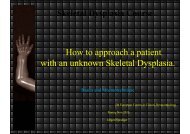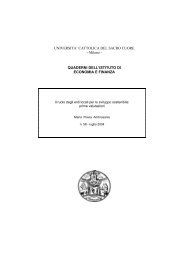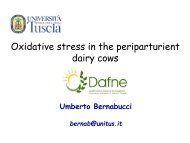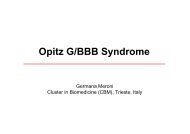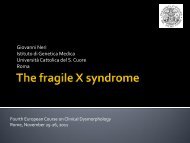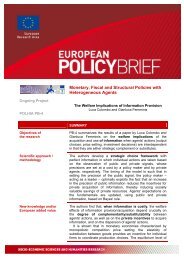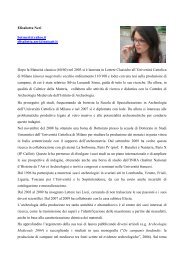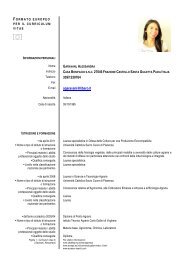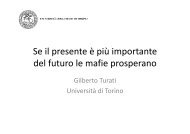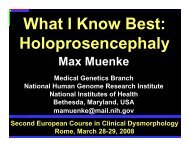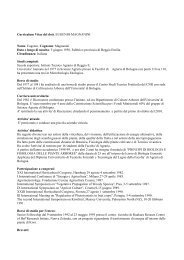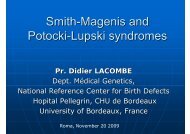Globalisation and Efficiency in the Fixed-odds Soccer Betting ... - Istituti
Globalisation and Efficiency in the Fixed-odds Soccer Betting ... - Istituti
Globalisation and Efficiency in the Fixed-odds Soccer Betting ... - Istituti
You also want an ePaper? Increase the reach of your titles
YUMPU automatically turns print PDFs into web optimized ePapers that Google loves.
Address for correspondence:<br />
<strong>Globalisation</strong> <strong>and</strong> <strong>Efficiency</strong> <strong>in</strong> <strong>the</strong><br />
<strong>Fixed</strong>-<strong>odds</strong> <strong>Soccer</strong> Bett<strong>in</strong>g Market<br />
by<br />
David Forrest<br />
<strong>and</strong><br />
Robert Simmons<br />
Centre for <strong>the</strong> Study of Gambl<strong>in</strong>g <strong>and</strong> Commercial Gam<strong>in</strong>g<br />
University of Salford<br />
December, 2001<br />
Dr David Forrest<br />
Centre for <strong>the</strong> Study of Gambl<strong>in</strong>g <strong>and</strong> Commercial Gam<strong>in</strong>g<br />
University of Salford<br />
Salford<br />
M5 4WT<br />
e-mail: d.k.forrest@salford.ac.uk<br />
telephone: + 44 161 295 3674<br />
telefax: + 44 161 295 2130
ABSTRACT<br />
The paper analyses patterns of <strong>odds</strong> <strong>in</strong> <strong>the</strong> British soccer bett<strong>in</strong>g market over four seasons from<br />
1997. It uncovers limited evidence for home-away <strong>and</strong> favourite-longshot bias identified <strong>in</strong><br />
previous research. It also considers <strong>the</strong> hi<strong>the</strong>rto unexplored issue of <strong>the</strong> extent to which <strong>odds</strong> set<br />
by bookmakers reflect <strong>the</strong> different numbers of supporters that different football clubs have.<br />
However, by <strong>the</strong> end of <strong>the</strong> period, <strong>the</strong> growth, from 1999, of a significant offshore sector with<br />
tax-free bett<strong>in</strong>g opportunities <strong>and</strong> greater competition had moved <strong>the</strong> market strongly towards<br />
efficiency.<br />
JEL Classification: L83<br />
1
1. Introduction<br />
A volum<strong>in</strong>ous literature, comprehensively surveyed by Sauer (1998) <strong>and</strong> Vaughan Williams<br />
(1999), concerns itself with efficiency <strong>in</strong> bett<strong>in</strong>g markets. The core question addressed is<br />
whe<strong>the</strong>r <strong>and</strong> to what extent <strong>the</strong> terms of bets on horse races or sports events capture accurately<br />
<strong>the</strong> objective probabilities of <strong>the</strong> possible outcomes. Given <strong>the</strong> size of wager<strong>in</strong>g turnover <strong>in</strong><br />
many jurisdictions, <strong>the</strong> question is <strong>in</strong>terest<strong>in</strong>g <strong>in</strong> itself; but most authors give it fur<strong>the</strong>r <strong>and</strong> wider<br />
significance by portray<strong>in</strong>g <strong>the</strong>se specialised f<strong>in</strong>ancial markets (where bettors are purchas<strong>in</strong>g state<br />
cont<strong>in</strong>gent claims on ‘w<strong>in</strong>n<strong>in</strong>gs’) as offer<strong>in</strong>g opportunities for learn<strong>in</strong>g general lessons about <strong>the</strong><br />
ability of economic agents to process <strong>in</strong>formation <strong>and</strong> about how successfully <strong>the</strong> <strong>in</strong>formation is<br />
transmitted <strong>in</strong>to market prices.<br />
The largest number of studies relates to horse rac<strong>in</strong>g <strong>in</strong> <strong>the</strong> United States. 1 There, bett<strong>in</strong>g<br />
is organised on a pari mutuel (or pool) basis such that <strong>the</strong> relative <strong>odds</strong> of <strong>the</strong> competitors <strong>in</strong> a<br />
race depend only on <strong>the</strong> relative amounts wagered on each horse. Relative prices are <strong>the</strong>refore<br />
entirely dem<strong>and</strong>-determ<strong>in</strong>ed. If observed prices are <strong>in</strong>efficient <strong>in</strong> <strong>the</strong> sense of fail<strong>in</strong>g to reflect<br />
objective probabilities, this can be attributable only to bettor behaviour: ei<strong>the</strong>r bettors suffer<br />
systematic misperceptions (uncorrected by arbitrageurs) or <strong>the</strong> explanation lies <strong>in</strong> <strong>the</strong>ir<br />
preferences (e.g. <strong>the</strong> well-known favourite-longshot bias may be generated by utility functions<br />
characterisable as risk-lov<strong>in</strong>g).<br />
A second way <strong>in</strong> which bett<strong>in</strong>g may be organised is <strong>in</strong> a bookmaker market. This is <strong>the</strong><br />
dom<strong>in</strong>ant form of gambl<strong>in</strong>g on horse races <strong>in</strong> Brita<strong>in</strong>, Irel<strong>and</strong> <strong>and</strong> many Commonwealth<br />
countries <strong>and</strong> is also favoured for wager<strong>in</strong>g on team sports <strong>in</strong> <strong>the</strong> United States. In <strong>the</strong>se<br />
2
markets, a bookmaker announces <strong>the</strong> terms on which bets may be made (<strong>the</strong>se may be<br />
summarised ei<strong>the</strong>r by a quotation of <strong>the</strong> <strong>odds</strong> or, <strong>in</strong> <strong>the</strong> cases of American football <strong>and</strong><br />
basketball, by po<strong>in</strong>ts spreads). Clients may strike a bet at whatever terms are offered at <strong>the</strong> time<br />
but <strong>the</strong>se terms will be adjusted <strong>in</strong> light of any subsequent bets as bookmakers receive guidance<br />
from <strong>the</strong> weight of money wagered on <strong>the</strong> various outcomes. The ‘prices’ observed at <strong>the</strong> end of<br />
<strong>the</strong> bett<strong>in</strong>g period will <strong>the</strong>refore reflect <strong>in</strong>teraction between <strong>the</strong> dem<strong>and</strong> <strong>and</strong> supply sides of <strong>the</strong><br />
market. Any ‘<strong>in</strong>efficiency’ observed <strong>in</strong> <strong>the</strong> clos<strong>in</strong>g <strong>odds</strong> (or po<strong>in</strong>ts spread) could be <strong>the</strong> result of<br />
bettor behaviour (as <strong>in</strong> pari mutuel markets) but authors such as Sh<strong>in</strong> (1993) have drawn<br />
attention to <strong>the</strong> potential for sources of <strong>in</strong>efficiency alternatively to lie on <strong>the</strong> supply side (where<br />
bookmakers may, e.g. be respond<strong>in</strong>g to concern over <strong>in</strong>sider trad<strong>in</strong>g).<br />
There is however, a third <strong>and</strong> unusual form of bett<strong>in</strong>g market, which is <strong>the</strong> focus of this<br />
paper. In ‘fixed-<strong>odds</strong> bett<strong>in</strong>g’ on British football (soccer), bookmakers offer <strong>odds</strong> at <strong>the</strong><br />
beg<strong>in</strong>n<strong>in</strong>g of <strong>the</strong> trad<strong>in</strong>g period (which is of several days duration) <strong>and</strong> <strong>the</strong>se are <strong>the</strong>n available<br />
up to <strong>the</strong> time of <strong>the</strong> game, regardless of bettors’ response to <strong>the</strong> terms offered. Prices are purely<br />
supply-determ<strong>in</strong>ed (though, of course, <strong>the</strong> bookmakers may take <strong>in</strong>to account predicted client<br />
response to different <strong>odds</strong>). We exam<strong>in</strong>e this market to assess <strong>the</strong> degree of efficiency exhibited<br />
by <strong>the</strong> <strong>odds</strong>. In a sense, this is a particularly challeng<strong>in</strong>g market on which to test an efficiency<br />
hypo<strong>the</strong>sis: where <strong>the</strong> <strong>odds</strong> are allowed to move, as <strong>in</strong> pari mutuel or <strong>in</strong> conventional bookmaker<br />
markets, price is <strong>in</strong>fluenced by diverse sources of <strong>in</strong>formation driv<strong>in</strong>g <strong>the</strong> trad<strong>in</strong>g decisions of<br />
bettors; <strong>the</strong>se extra sources of <strong>in</strong>formation are unused <strong>in</strong> fixed-<strong>odds</strong> bett<strong>in</strong>g where bookmakers<br />
must rely on <strong>the</strong>ir own expertise (<strong>and</strong> perhaps <strong>the</strong>ir experience of patterns of dem<strong>and</strong>).<br />
3
Section 2 outl<strong>in</strong>es <strong>the</strong> ma<strong>in</strong> features of <strong>the</strong> football bett<strong>in</strong>g market <strong>in</strong> <strong>the</strong> United<br />
K<strong>in</strong>gdom, Section 3 considers <strong>the</strong> small but grow<strong>in</strong>g body of previous literature <strong>and</strong> Section 4<br />
describes our data. In Sections 5 <strong>and</strong> 6, we propose <strong>and</strong> implement tests for specific biases <strong>in</strong><br />
<strong>odds</strong> <strong>and</strong> <strong>in</strong>clude consideration of a previously ignored issue, whe<strong>the</strong>r <strong>odds</strong> reflect levels of<br />
<strong>in</strong>terest <strong>in</strong> <strong>and</strong> support for particular football clubs <strong>and</strong> whe<strong>the</strong>r this ‘sentiment’ <strong>in</strong> <strong>the</strong> market can<br />
be exploited for wager<strong>in</strong>g ga<strong>in</strong>. Section 7 offers <strong>in</strong>terpretation <strong>and</strong> concludes.<br />
2. Bett<strong>in</strong>g on UK soccer matches<br />
All large British bookmakers offer <strong>odds</strong> on <strong>the</strong> possible outcomes (home team w<strong>in</strong>, away team<br />
w<strong>in</strong>, draw) of all games played under <strong>the</strong> auspices of <strong>the</strong> English (as well as <strong>the</strong> Scottish)<br />
professional leagues. 2 The bulk of matches are played on Saturday afternoons between August<br />
<strong>and</strong> May <strong>and</strong> a typical Saturday may feature sixty such games <strong>in</strong> Engl<strong>and</strong> <strong>and</strong> Scotl<strong>and</strong>. 3 The<br />
<strong>odds</strong> setters of an <strong>in</strong>dividual bookmak<strong>in</strong>g firm meet at <strong>the</strong> beg<strong>in</strong>n<strong>in</strong>g of <strong>the</strong> week (Sharpe, 1997)<br />
<strong>and</strong> <strong>the</strong> <strong>odds</strong> <strong>the</strong>y decide are pr<strong>in</strong>ted on to entry forms (known as coupons) which are <strong>the</strong>n<br />
available all week. Bets may be made right up to <strong>the</strong> start of <strong>the</strong> relevant match(es) by visit<strong>in</strong>g<br />
<strong>the</strong> bookmaker’s shop or, <strong>in</strong> most cases, by telephone or <strong>in</strong>ternet, us<strong>in</strong>g a credit card. Such<br />
bett<strong>in</strong>g has been <strong>in</strong>creas<strong>in</strong>gly popular. M<strong>in</strong>tel Intelligence Report (2001) commented that<br />
“football bett<strong>in</strong>g is <strong>the</strong> fastest-grow<strong>in</strong>g form of gambl<strong>in</strong>g <strong>in</strong> <strong>the</strong> UK”. Global Bett<strong>in</strong>g <strong>and</strong><br />
Gam<strong>in</strong>g Consultants (2001) cite an op<strong>in</strong>ion poll <strong>in</strong> 1998 that <strong>in</strong>dicated nearly four million adults<br />
bett<strong>in</strong>g weekly on sports <strong>and</strong> claimed annual UK turnover of sports bett<strong>in</strong>g to be about £2bn.<br />
The huge majority of this turnover will relate to football though <strong>the</strong> figure <strong>in</strong>cludes not only<br />
bett<strong>in</strong>g on results but also wager<strong>in</strong>g on o<strong>the</strong>r aspects of <strong>the</strong> game such as <strong>the</strong> identity of <strong>the</strong> first<br />
scorer <strong>in</strong> a match.<br />
4
Crafts (1985), <strong>in</strong> a paper on <strong>in</strong>sider trad<strong>in</strong>g <strong>in</strong> horse bett<strong>in</strong>g markets, remarked that <strong>the</strong><br />
will<strong>in</strong>gness of bookmakers to commit <strong>the</strong>mselves to ‘fixed-<strong>odds</strong>’ <strong>in</strong> respect of soccer games is<br />
testimony to <strong>the</strong> low relevance of <strong>in</strong>side <strong>in</strong>formation <strong>in</strong> <strong>the</strong> sport. We would not necessarily<br />
share this <strong>in</strong>terpretation. Bookmaker bett<strong>in</strong>g grew dur<strong>in</strong>g <strong>the</strong> 1980s to compete with an<br />
alternative form of bett<strong>in</strong>g on football, <strong>the</strong> pools, at that time a mass-participation long-<strong>odds</strong> (<strong>and</strong><br />
pari mutuel) gambl<strong>in</strong>g medium where <strong>the</strong> idea was to select a group of games likely to end <strong>in</strong><br />
draws. It was natural that bookmakers would challenge <strong>the</strong> pre-exist<strong>in</strong>g competition by ap<strong>in</strong>g<br />
<strong>the</strong>ir entry forms. 4 Pr<strong>in</strong>t<strong>in</strong>g bookmaker coupons similar to those of <strong>the</strong> pools necessitated fix<strong>in</strong>g<br />
<strong>the</strong> <strong>odds</strong> <strong>in</strong> advance of <strong>the</strong> bett<strong>in</strong>g period. However, giv<strong>in</strong>g up <strong>the</strong> right to shift <strong>the</strong> <strong>odds</strong> <strong>in</strong><br />
response to dem<strong>and</strong> was only feasible <strong>and</strong> prudent because of alternative rules available to<br />
bookmakers to protect <strong>the</strong>mselves aga<strong>in</strong>st <strong>the</strong> exploitation of <strong>in</strong>side (or just new) <strong>in</strong>formation.<br />
The rules to which we refer constitute an important feature of <strong>the</strong> market, only<br />
occasionally <strong>and</strong> <strong>in</strong>cidentally mentioned <strong>in</strong> previous academic studies of football bett<strong>in</strong>g: it is not<br />
normally possible to bet on <strong>the</strong> outcome of a s<strong>in</strong>gle match. Only comb<strong>in</strong>ation bets have<br />
traditionally been allowed. 5 This rule had its orig<strong>in</strong> with <strong>the</strong> football authorities <strong>the</strong>mselves<br />
which licensed use of <strong>the</strong> fixture lists <strong>and</strong> imposed a prohibition on s<strong>in</strong>gle game bets <strong>in</strong> order to<br />
protect <strong>the</strong> <strong>in</strong>tegrity of <strong>the</strong> sport aga<strong>in</strong>st temptations of match fix<strong>in</strong>g. However, bookmakers<br />
have imposed more restrictive rules than <strong>the</strong> Football Association requires (<strong>and</strong>, moreover, differ<br />
from each o<strong>the</strong>r <strong>in</strong> <strong>the</strong> severity of <strong>the</strong>ir restrictions on types of bet) <strong>and</strong> <strong>the</strong>ir rules must <strong>the</strong>refore<br />
be understood as a part of bus<strong>in</strong>ess strategy ra<strong>the</strong>r than someth<strong>in</strong>g imposed exogenously.<br />
5
With some exceptions (e.g. televised matches), bookmakers have not normally permitted<br />
anyth<strong>in</strong>g less than a ‘treble’ bet. Such a rule is protection aga<strong>in</strong>st those with <strong>in</strong>side or new<br />
knowledge. If one knew, as if with certa<strong>in</strong>ty, that team A would defeat team B, one could only<br />
be sure of us<strong>in</strong>g <strong>the</strong> knowledge to make a w<strong>in</strong>n<strong>in</strong>g bet by choos<strong>in</strong>g two o<strong>the</strong>r matches <strong>and</strong><br />
mak<strong>in</strong>g a series of treble bets <strong>in</strong> each of which A was wagered to w<strong>in</strong> but each time with a<br />
different pair of forecasts from <strong>the</strong> o<strong>the</strong>r two games. The expense would normally make it<br />
impossible to take a position where a profit was certa<strong>in</strong> <strong>and</strong>, even tak<strong>in</strong>g <strong>the</strong> risk of cover<strong>in</strong>g only<br />
some of <strong>the</strong> comb<strong>in</strong>ations of outcomes of <strong>the</strong> o<strong>the</strong>r two games, expected profit would be eroded<br />
or elim<strong>in</strong>ated altoge<strong>the</strong>r.<br />
An alternative to bett<strong>in</strong>g on three or more matches has, however, emerged <strong>in</strong> recent years.<br />
Bookmakers permit ‘double’ bets on a s<strong>in</strong>gle game where <strong>the</strong> two halves of <strong>the</strong> bet relate to (i)<br />
<strong>the</strong> half-time score <strong>in</strong> <strong>the</strong> game (home, away, draw) <strong>and</strong> (ii) <strong>the</strong> full-time score <strong>in</strong> <strong>the</strong> game<br />
(aga<strong>in</strong> home, away or draw). Each bookmaker will offer <strong>the</strong> chance of such a double on any<br />
match on <strong>the</strong> coupon. The <strong>odds</strong> are not fixed match-by-match but are l<strong>in</strong>ked to <strong>the</strong> <strong>odds</strong> quoted<br />
for <strong>the</strong> chosen team on <strong>the</strong> ma<strong>in</strong> entry form.<br />
As a typical example, suppose <strong>the</strong> <strong>odds</strong> aga<strong>in</strong>st home team A defeat<strong>in</strong>g away team B are<br />
6/4. Correspond<strong>in</strong>g to <strong>the</strong>se <strong>odds</strong>, a bookmaker offers bets <strong>in</strong>clud<strong>in</strong>g <strong>the</strong> follow<strong>in</strong>g:<br />
A leads at half-time, A leads at full-time 7/2.<br />
Draw at half-time, A leads at full-time 9/2.<br />
B leads at half-time, A leads at full-time 22/1.<br />
6
Were a s<strong>in</strong>gle bet permitted on A at 6/4, one would need to spend £0.40 to receive £1 <strong>in</strong><br />
<strong>the</strong> event of an A victory. By employ<strong>in</strong>g <strong>the</strong> device of bett<strong>in</strong>g on <strong>the</strong> three comb<strong>in</strong>ations which<br />
can end <strong>in</strong> a w<strong>in</strong> for A, one can ensure a pay-back of £1 for a spend of £0.447. 6 This represents a<br />
shad<strong>in</strong>g of <strong>the</strong> <strong>odds</strong> by 17.7% from 1.5 to 1 to 1.24 to 1. We <strong>in</strong>terpret this 17.7% as a sort of<br />
<strong>in</strong>surance premium to protect bookmakers aga<strong>in</strong>st <strong>in</strong>sider deal<strong>in</strong>g: if a client wants to bet on a<br />
s<strong>in</strong>gle match he can do so but, <strong>in</strong> case his wishes are <strong>in</strong>spired by <strong>the</strong> possession of fresh news or<br />
<strong>in</strong>side <strong>in</strong>formation, he must accept <strong>odds</strong> approximately 18% less favourable than <strong>the</strong> published<br />
<strong>odds</strong>.<br />
The significance of <strong>the</strong> ‘<strong>in</strong>surance premium’ is that it reduces <strong>the</strong> likelihood that any bias<br />
identified <strong>in</strong> <strong>the</strong> published <strong>odds</strong> can be exploited via <strong>the</strong> formulation of appropriate trad<strong>in</strong>g rules.<br />
For such bett<strong>in</strong>g to have been profitable <strong>in</strong> <strong>the</strong> past, <strong>the</strong> bias would have had to be sufficiently<br />
pronounced that bets could overcome not only <strong>the</strong> 9% tax <strong>and</strong> <strong>the</strong> (approximately) 10.5%<br />
bookmaker’ take 7 but also <strong>the</strong> implicit charge of 18% associated with be<strong>in</strong>g allowed to wager on<br />
a s<strong>in</strong>gle game. The total take-out rate account<strong>in</strong>g for all three deductions, (1-(0.91*0.823)) +<br />
0.105, is 35.6%, which is not much less than <strong>the</strong> figure of 50% for <strong>the</strong> UK National Lottery.<br />
Transactions costs <strong>in</strong> soccer bett<strong>in</strong>g have, however, been fall<strong>in</strong>g. From May, 1999, a<br />
number of large British bookmakers set up offshore bett<strong>in</strong>g firms <strong>in</strong> jurisdictions such as<br />
Gibraltar <strong>and</strong> Guernsey to permit wagers to be placed via telephone or <strong>in</strong>ternet without any<br />
liability to bett<strong>in</strong>g duty. Moreover, competition amongst offshore operations eroded <strong>the</strong> severity<br />
of restrictions on s<strong>in</strong>gle bets so that, e.g., it is now possible to make a s<strong>in</strong>gle bet on any Premier<br />
7
League fixture. In response to <strong>the</strong> move of bookmak<strong>in</strong>g offshore, bett<strong>in</strong>g duty was removed <strong>in</strong><br />
<strong>the</strong> United K<strong>in</strong>gdom <strong>in</strong> October, 2001. This fall <strong>in</strong> transactions costs would be expected to<br />
dim<strong>in</strong>ish <strong>the</strong> extent to which bookmakers could deliberately bias <strong>the</strong>ir <strong>odds</strong> without attract<strong>in</strong>g <strong>the</strong><br />
attention of professional bettors seek<strong>in</strong>g opportunities to make positive expected profits.<br />
3. Previous studies of UK soccer bett<strong>in</strong>g<br />
In view of <strong>the</strong> novelty of <strong>the</strong> market, <strong>the</strong>re have been surpris<strong>in</strong>gly few academic studies until<br />
very recently. Pope <strong>and</strong> Peel (1989) employed data from <strong>the</strong> 1981/2 football season <strong>and</strong><br />
regressed <strong>the</strong> outcome of <strong>the</strong> match (def<strong>in</strong>ed by a b<strong>in</strong>ary variable equal to one for a named result)<br />
on <strong>the</strong> bookmaker <strong>odds</strong> quoted for that result. In <strong>the</strong> case of home w<strong>in</strong>s <strong>and</strong> away w<strong>in</strong>s, <strong>the</strong><br />
coefficient on <strong>the</strong> bookmaker <strong>odds</strong> was never significantly different from one (at <strong>the</strong> 5% level)<br />
<strong>in</strong>dicat<strong>in</strong>g that <strong>the</strong>re was no statistically significant bias <strong>in</strong> <strong>odds</strong>-sett<strong>in</strong>g.<br />
Pope <strong>and</strong> Peel next estimated regressions <strong>in</strong> which measures of newspapers tipster<br />
forecasts were <strong>in</strong>cluded as additional explanatory variables. Though tips had only low<br />
<strong>in</strong>formational content, <strong>the</strong>re was some <strong>in</strong>dication that bettors could use <strong>the</strong>m to reduce <strong>the</strong>ir<br />
expected losses <strong>and</strong> it was also possible for bettors to benefit by study<strong>in</strong>g <strong>the</strong> <strong>odds</strong> set by<br />
different bookmakers, <strong>the</strong> pool<strong>in</strong>g of <strong>in</strong>formation unsurpris<strong>in</strong>gly assist<strong>in</strong>g <strong>in</strong> <strong>the</strong> identification of<br />
games where a ‘fairer’ bet might be made at a selected bookmaker. However, a 10% bett<strong>in</strong>g tax<br />
was noted to be an impediment to profitable trad<strong>in</strong>g rules, so that that market appeared to be<br />
weak-efficient <strong>in</strong> <strong>the</strong> Thaler-Ziemba (1988) sense of <strong>the</strong>re be<strong>in</strong>g no opportunity to f<strong>in</strong>d bets with<br />
positive expected value. Our comment that one should take account of <strong>the</strong> worsen<strong>in</strong>g of <strong>odds</strong><br />
implicit <strong>in</strong> restrictions aga<strong>in</strong>st s<strong>in</strong>gle bets would re<strong>in</strong>force <strong>the</strong>ir conclusion. One should also note<br />
8
that <strong>the</strong> data analysed by Pope <strong>and</strong> Peel are now nearly 20 years old <strong>and</strong> perta<strong>in</strong> to a period when<br />
bett<strong>in</strong>g volumes were negligible compared with <strong>the</strong>ir present importance (Jackson, 1994).<br />
Bookmakers now have much more <strong>in</strong>centive to pay for <strong>the</strong> specialised talent necessary to ensure<br />
accuracy <strong>in</strong> <strong>odds</strong> sett<strong>in</strong>g. Conceivably <strong>the</strong>refore, any tendency to <strong>in</strong>efficiency may have been<br />
elim<strong>in</strong>ated s<strong>in</strong>ce Pope <strong>and</strong> Peel’s pioneer<strong>in</strong>g contributions.<br />
Dixon <strong>and</strong> Coles (1997) adopt a model proposed by Maher (1982) to forecast <strong>the</strong> results<br />
of football games played over <strong>the</strong> 1992-95 period. The score of each team is modelled as an<br />
<strong>in</strong>dependent Poisson distribution with mean determ<strong>in</strong>ed by <strong>the</strong> past goal-scor<strong>in</strong>g record of that<br />
team <strong>and</strong> <strong>the</strong> past goal-conced<strong>in</strong>g record of <strong>the</strong> oppos<strong>in</strong>g team. 8 Probabilities of home, away <strong>and</strong><br />
draw outcomes are extracted from <strong>the</strong> estimated model <strong>and</strong> a simulation performed for a filter-<br />
bett<strong>in</strong>g strategy whereby a bet is placed on any outcome for which <strong>the</strong> probability <strong>in</strong>dicated by<br />
<strong>the</strong> model exceeds (by a nom<strong>in</strong>ated marg<strong>in</strong>) <strong>the</strong> probability implicit <strong>in</strong> <strong>the</strong> bookmaker’s <strong>odds</strong>.<br />
With <strong>the</strong> required ratio of model probability to bookmaker probability set at 1.2, <strong>the</strong><br />
expected return to such bett<strong>in</strong>g is reported as “borderl<strong>in</strong>e significantly different from –0.11, <strong>the</strong><br />
expected return to a r<strong>and</strong>om bett<strong>in</strong>g strategy”. This constitutes evidence aga<strong>in</strong>st strong<br />
efficiency <strong>in</strong> <strong>odds</strong> to <strong>the</strong> extent that some bets <strong>in</strong>deed appear to yield higher expected returns<br />
than o<strong>the</strong>r bets. Whe<strong>the</strong>r <strong>the</strong>re is sufficient evidence of a potentially profitable bett<strong>in</strong>g strategy is<br />
more open to question. From <strong>the</strong> authors’ figure 4, allow<strong>in</strong>g for <strong>the</strong> worse <strong>odds</strong> associated with<br />
bett<strong>in</strong>g on a s<strong>in</strong>gle match would require <strong>the</strong> filter ratio to be raised to about 1.3 for <strong>the</strong> expected<br />
return to become positive. Figures are not presented on <strong>the</strong> number of bets that can be made <strong>in</strong> a<br />
season at each value of <strong>the</strong> filter ratio but it is a familiar feature of horse bett<strong>in</strong>g that ‘w<strong>in</strong>n<strong>in</strong>g’<br />
9
strategies require considerable effort <strong>and</strong> data analysis while identify<strong>in</strong>g frustrat<strong>in</strong>gly few<br />
occasions on which a bet should be placed (Crafts, 1994).<br />
Kuypers (2000), Dobson <strong>and</strong> Goddard (2001) <strong>and</strong> Goddard <strong>and</strong> Asimakopoulos (2001)<br />
follow similar procedures to Dixon <strong>and</strong> Coles <strong>in</strong> that <strong>the</strong>y employ a forecast<strong>in</strong>g model to identify<br />
matches where <strong>the</strong> bookmaker probability <strong>in</strong> respect of one of <strong>the</strong> possible outcomes has been<br />
underestimated to some specified degree. However, <strong>the</strong>y employ ordered profit models which<br />
can encompass a variety of historic <strong>in</strong>formation beyond just <strong>the</strong> goal scor<strong>in</strong>g record of each team.<br />
Kuypers was able to identify a limited number of profitable bets <strong>in</strong> season 1994-5 us<strong>in</strong>g a model<br />
estimated for 1993-4 but only when <strong>the</strong> forecast<strong>in</strong>g model <strong>in</strong>cluded not only team quality data<br />
but also <strong>odds</strong> data (i.e. he exploited a comb<strong>in</strong>ation of fundamental <strong>and</strong> technical analysis). The<br />
research reported <strong>in</strong> Dobson-Goddard <strong>and</strong> Goddard-Asimakopoulos draws on a very rich<br />
forecast<strong>in</strong>g model estimated over ten seasons to select value bets <strong>in</strong> 1998-9 <strong>and</strong> 1999-2000.<br />
They f<strong>in</strong>d positive profit opportunities from us<strong>in</strong>g <strong>the</strong> model but only late <strong>in</strong> <strong>the</strong> season when <strong>the</strong><br />
forecast<strong>in</strong>g model can <strong>in</strong>clude much more current season <strong>in</strong>formation <strong>and</strong> can also benefit from<br />
<strong>the</strong> use of a dummy variable that highlights teams for whom a particular match has strong<br />
promotion or relegation significance. The positive profit depends, however, on be<strong>in</strong>g able to bet<br />
on s<strong>in</strong>gle matches <strong>and</strong> on not hav<strong>in</strong>g to pay tax. Goddard <strong>and</strong> Asimakopoulos remark that tax is<br />
now <strong>in</strong>deed abolished; but, of course, bookmakers may now for that reason alone reduce <strong>the</strong><br />
extent to which <strong>the</strong>y will offer ‘biased’ <strong>odds</strong>.<br />
Dixon <strong>and</strong> Pope (1996) po<strong>in</strong>t to <strong>in</strong>dications of a degree of <strong>in</strong>efficiency <strong>in</strong> <strong>the</strong> football<br />
bett<strong>in</strong>g market associated not with a failure of <strong>the</strong> <strong>odds</strong> to capture <strong>in</strong>formation on <strong>the</strong><br />
10
performance <strong>in</strong> <strong>the</strong> past of particular teams but with patterns <strong>in</strong> <strong>the</strong> <strong>odds</strong> across matches.<br />
Evidence related to three bookmakers <strong>and</strong> <strong>the</strong>ir <strong>odds</strong> <strong>in</strong> English football games over 1992-6<br />
suggested that appreciably lower losses would accrue to bettors back<strong>in</strong>g home w<strong>in</strong>s or draws<br />
ra<strong>the</strong>r than away w<strong>in</strong>s. Fur<strong>the</strong>r, an exam<strong>in</strong>ation of returns related to different ranges of <strong>odds</strong><br />
po<strong>in</strong>ted to a reverse favourite-longshot bias: wagers on outcomes with <strong>the</strong> shortest <strong>odds</strong> (i.e. <strong>the</strong><br />
highest bookmaker probability) attracted <strong>the</strong> largest losses. Ca<strong>in</strong>, Law <strong>and</strong> Peel (2000), on <strong>the</strong><br />
o<strong>the</strong>r h<strong>and</strong>, however, noted superior (though still negative) returns accrued to bets on strong<br />
favourites; but <strong>the</strong>ir evidence was drawn from only one year, 1991-2.<br />
The evidence presented by Dixon <strong>and</strong> Pope <strong>in</strong> support of <strong>the</strong> proposition that <strong>odds</strong><br />
underestimated <strong>the</strong> chances of home teams <strong>and</strong> underdogs is highly suggestive. However, we<br />
prefer to assess <strong>the</strong> existence <strong>and</strong> magnitude of <strong>the</strong>se <strong>and</strong> o<strong>the</strong>r possible biases by multivariate<br />
regression analysis. A comparison of returns to back<strong>in</strong>g short- <strong>and</strong> long-<strong>odds</strong> teams may for<br />
example generate mislead<strong>in</strong>g estimates of <strong>the</strong> size of any bias if <strong>odds</strong> are correlated with whe<strong>the</strong>r<br />
or not a team enjoys home advantage. Thus, <strong>the</strong> superior return to bett<strong>in</strong>g on strong favourites,<br />
noted by Ca<strong>in</strong>, Law <strong>and</strong> Peel, may <strong>in</strong> fact be generated by home-away bias <strong>in</strong> bett<strong>in</strong>g <strong>odds</strong> s<strong>in</strong>ce<br />
strong favourites are almost always play<strong>in</strong>g at home. 9 As implied by work from Golec <strong>and</strong><br />
Tamark<strong>in</strong> (1991) on American football po<strong>in</strong>ts-spread bett<strong>in</strong>g, <strong>the</strong> detection <strong>and</strong> estimation of<br />
favourite-longshot bias (or its reverse) requires a multivariate approach to ensure that any<br />
estimation is not contam<strong>in</strong>ated by <strong>the</strong> presence of a simultaneous home-away bias. In this paper,<br />
we test for <strong>the</strong>se biases <strong>and</strong> also for a possible bias l<strong>in</strong>ked to disparity <strong>in</strong> fan-bett<strong>in</strong>g volumes<br />
when oppos<strong>in</strong>g teams have very unequal numbers of supporters.<br />
11
4. Data<br />
Our model was estimated for each of four football seasons from 1997-8 to 2000-1. For each<br />
season, we attempted to <strong>in</strong>clude all matches <strong>in</strong> <strong>the</strong> English professional leagues (i.e. <strong>the</strong> FA<br />
Premier League <strong>and</strong> Divisions One, Two <strong>and</strong> Three of The Football League) that were played on<br />
a Friday, Saturday or Sunday (<strong>the</strong>se are <strong>the</strong> days whose fixtures are <strong>in</strong>cluded on bookmakers’<br />
weekly coupons). The outcome of each match was noted from <strong>the</strong> relevant volume of The<br />
Rothman’s Football Year Book.<br />
Bett<strong>in</strong>g <strong>odds</strong> used <strong>in</strong> this study are for Super <strong>Soccer</strong>. Super <strong>Soccer</strong> <strong>odds</strong> are those<br />
supplied by a specialist <strong>odds</strong>-sett<strong>in</strong>g firm <strong>and</strong> adopted by nearly all <strong>the</strong> small, <strong>in</strong>dependent<br />
bookmakers of <strong>the</strong> United K<strong>in</strong>gdom (coupons carry both <strong>the</strong> name Super <strong>Soccer</strong> <strong>and</strong> <strong>the</strong> name of<br />
<strong>the</strong> local bookmaker who has subscribed to <strong>the</strong> service). The four largest national bookmak<strong>in</strong>g<br />
firms quote <strong>the</strong>ir own <strong>in</strong>dividual <strong>odds</strong>. However, <strong>the</strong>se are highly correlated with each o<strong>the</strong>r <strong>and</strong><br />
with Super <strong>Soccer</strong>’s: we collected data from all five sources for <strong>the</strong> first of our seasons, 1997-8,<br />
<strong>and</strong> replicated <strong>the</strong> work reported below us<strong>in</strong>g, <strong>in</strong> turn, <strong>the</strong> <strong>odds</strong> from each of <strong>the</strong> o<strong>the</strong>r four firms.<br />
The pattern of our results was very similar irrespective of which bookmaker was used <strong>and</strong> we are<br />
<strong>the</strong>refore confident that our f<strong>in</strong>d<strong>in</strong>gs for Super <strong>Soccer</strong> are representative of <strong>the</strong> sector as a whole.<br />
1998-9 <strong>and</strong> 1999-2000 Super <strong>Soccer</strong> <strong>odds</strong> were obta<strong>in</strong>ed directly from entry forms<br />
(coupons); a small number of coupons were miss<strong>in</strong>g from our set <strong>and</strong> matches for <strong>the</strong>se weeks<br />
are excluded from <strong>the</strong> sample. For 1997-8 <strong>and</strong> 1998-9, we collected Super <strong>Soccer</strong> <strong>odds</strong> from<br />
archive copies of <strong>the</strong> daily bett<strong>in</strong>g newspaper, The Rac<strong>in</strong>g Post. Both on <strong>the</strong> coupons <strong>and</strong> <strong>in</strong> <strong>the</strong><br />
newspaper, <strong>odds</strong> aga<strong>in</strong>st any team i w<strong>in</strong>n<strong>in</strong>g were quoted <strong>in</strong> <strong>the</strong> traditional form, a/b. We<br />
12
converted <strong>the</strong>se <strong>odds</strong> so that <strong>the</strong>y were expressed <strong>in</strong> <strong>the</strong> alternative form of probability-<strong>odds</strong> such<br />
that <strong>the</strong> probability-<strong>odds</strong> of a w<strong>in</strong> for team i became b/(a+b). For example, with quoted <strong>odds</strong> of 4<br />
to 1, probability-<strong>odds</strong> were 1/5 or 0.20: one would have to spend £0.20 to secure a payout of £1<br />
<strong>in</strong> <strong>the</strong> event of team i w<strong>in</strong>n<strong>in</strong>g. 0.20 would, however, not be <strong>the</strong> implicit bookmaker-probability<br />
of a w<strong>in</strong> for team i because <strong>the</strong> sum of <strong>the</strong> probability-<strong>odds</strong> of <strong>the</strong> three possible outcomes (w<strong>in</strong>,<br />
loss or draw for team i) is always greater than one. Therefore, <strong>the</strong> bookmaker-probability of i<br />
w<strong>in</strong>n<strong>in</strong>g is obta<strong>in</strong>ed by divid<strong>in</strong>g <strong>the</strong> probability-<strong>odds</strong> for team i by <strong>the</strong> sum of <strong>the</strong> probability-<br />
<strong>odds</strong> of <strong>the</strong> three possible outcomes.<br />
A problem here is that <strong>the</strong> Rac<strong>in</strong>g Post, on which we relied for data from two of our four<br />
seasons, did not report <strong>odds</strong> for a draw but only for a home w<strong>in</strong> <strong>and</strong> for an away w<strong>in</strong>. However,<br />
<strong>in</strong> <strong>the</strong> two years for which we had coupons quot<strong>in</strong>g <strong>odds</strong> on each of <strong>the</strong> three possible results, <strong>the</strong><br />
sum of probability-<strong>odds</strong> was always close to 1.117, a figure reported by o<strong>the</strong>r authors for o<strong>the</strong>r<br />
bookmakers <strong>and</strong> one that <strong>in</strong>dicates a nom<strong>in</strong>al bookmaker take of 10.5%. 10 For <strong>the</strong> matches for<br />
which <strong>the</strong> data source was <strong>the</strong> Rac<strong>in</strong>g Post, we <strong>the</strong>refore estimated <strong>the</strong> bookmaker-probability of<br />
a team w<strong>in</strong>n<strong>in</strong>g a particular match by divid<strong>in</strong>g its probability-<strong>odds</strong> by <strong>the</strong> fixed number of 1.117.<br />
Thus <strong>in</strong> our example, <strong>the</strong> 4 to 1 team would have been attributed a bookmaker-probability of<br />
0.20/1.117 or 0.179. This was <strong>the</strong>n <strong>the</strong> figure used <strong>in</strong> empirical analysis.<br />
5. Model<br />
Authors such as, most recently, Goddard <strong>and</strong> Asimakopoulos (2001) demonstrate that –<br />
occasionally (<strong>in</strong> <strong>the</strong>ir case, <strong>in</strong> <strong>the</strong> clos<strong>in</strong>g weeks of <strong>the</strong> season) – sophisticated forecast<strong>in</strong>g models<br />
might capture more fundamental <strong>in</strong>formation than is encapsulated <strong>in</strong> bookmaker’s <strong>odds</strong>. But,<br />
13
given <strong>the</strong> grow<strong>in</strong>g volume of bett<strong>in</strong>g <strong>in</strong> recent years, bookmakers have had an <strong>in</strong>creas<strong>in</strong>g<br />
<strong>in</strong>centive to hire talent able accurately to process team quality <strong>and</strong> form <strong>in</strong>formation <strong>and</strong> it is<br />
<strong>the</strong>refore unsurpris<strong>in</strong>g that <strong>the</strong>se authors f<strong>in</strong>d (Table 2) that <strong>in</strong> general bookmaker <strong>odds</strong> perform<br />
similarly as well as forecast<strong>in</strong>g models <strong>in</strong> predict<strong>in</strong>g on-<strong>the</strong>-field outcomes.<br />
That is not to say, however, that <strong>the</strong> fixed <strong>odds</strong> bett<strong>in</strong>g market may be expected to be<br />
‘efficient’ consistently. A bookmaker’s function is not to provide <strong>odds</strong> that are objectively<br />
‘correct’ but to maximise profit. Accord<strong>in</strong>gly <strong>odds</strong> may be biased if this allows <strong>the</strong> bookmaker<br />
to take advantage of bettors’ misperceptions or preferences. For example, a consistent favourite-<br />
longshot bias (positive or negative) may emerge if bettors have preferences such that <strong>the</strong>y behave<br />
as if <strong>the</strong>y were risk-lov<strong>in</strong>g or risk-averse. Sentiment (as it is termed by Avery <strong>and</strong> Chevalier<br />
(1999)) may likewise play a role <strong>in</strong> <strong>the</strong> market. Most crucially perhaps, sports bett<strong>in</strong>g markets<br />
differ from typical f<strong>in</strong>ancial markets <strong>in</strong> that many <strong>in</strong>vestors view <strong>the</strong> expenditure not just as an<br />
<strong>in</strong>vestment but as a vehicle for becom<strong>in</strong>g more of a stakeholder <strong>in</strong> <strong>the</strong> team for which <strong>the</strong>y cheer<br />
ei<strong>the</strong>r <strong>in</strong> <strong>the</strong> stadium or more passively; bookmakers may price bets to take account of <strong>the</strong><br />
likelihood that <strong>the</strong> reservation price (<strong>odds</strong>) of such potential bettors will be <strong>in</strong>fluenced by <strong>the</strong>ir<br />
degree of attachment to <strong>the</strong>ir team as well as by <strong>the</strong>ir assessment of <strong>the</strong> ‘true’ probability of<br />
victory.<br />
Studies of wager<strong>in</strong>g markets have generally been discipl<strong>in</strong>ed by treat<strong>in</strong>g <strong>the</strong>m as just<br />
f<strong>in</strong>ancial markets which happen to be convenient to study because of such well-cited<br />
characteristics as <strong>the</strong> unambiguous term<strong>in</strong>ation po<strong>in</strong>t at which <strong>the</strong> value of <strong>the</strong> asset becomes<br />
def<strong>in</strong>itively measurable. Generally, <strong>the</strong>re has been no recognition that a large proportion of<br />
14
participants <strong>in</strong> <strong>the</strong> market may choose between possible bets not primarily <strong>in</strong> terms of <strong>the</strong>ir value<br />
as f<strong>in</strong>ancial assets but as consumer goods complementary to <strong>the</strong> sport itself. This has led to a<br />
tendency to search for, but not expla<strong>in</strong>, biases <strong>in</strong> <strong>the</strong> <strong>odds</strong> <strong>and</strong> has perhaps limited <strong>the</strong> dimensions<br />
of bias for which empirical evidence has been sought.<br />
Kuypers (2000) is an exception to <strong>the</strong> extent that he (importantly) sought to build a model<br />
where a profit maximis<strong>in</strong>g bookmaker sets (fixed) <strong>odds</strong> <strong>in</strong> <strong>the</strong> context of a market where <strong>the</strong>re is<br />
a mixture of ‘neutral’ bettors (who share <strong>the</strong> (objectively correct) bookmaker assessment of <strong>the</strong><br />
probabilities attached to each possible outcome from <strong>the</strong> match) <strong>and</strong> ‘committed’ bettors (whose<br />
views are coloured by <strong>the</strong>ir support for a particular team <strong>and</strong> are over-optimistic with regards to<br />
its probability of a w<strong>in</strong>). This appears a useful framework to represent <strong>the</strong> soccer bett<strong>in</strong>g market<br />
though we prefer to th<strong>in</strong>k of <strong>the</strong> ‘fan’ bettors as capable of assess<strong>in</strong>g w<strong>in</strong>-probabilities<br />
objectively even though behav<strong>in</strong>g as if <strong>the</strong>y had misperceptions: we <strong>in</strong>terpret <strong>the</strong>ir will<strong>in</strong>gness to<br />
wager as tak<strong>in</strong>g account of utility obta<strong>in</strong>ed from ‘support<strong>in</strong>g’ <strong>the</strong>ir team <strong>in</strong> <strong>the</strong> bett<strong>in</strong>g market as<br />
well as <strong>in</strong> <strong>the</strong> stadium.<br />
In his numerical example, Kuypers has ten supporters who have decided to bet <strong>and</strong> will<br />
wager on a particular outcome accord<strong>in</strong>g to <strong>the</strong>ir perception of <strong>the</strong> value offered by each of <strong>the</strong><br />
(three) possible bets. Four of <strong>the</strong> bettors are neutral <strong>and</strong> six are fans of Manchester United,<br />
Brita<strong>in</strong>’s most heavily supported club. Their opponents <strong>in</strong> Kuyper’s hypo<strong>the</strong>tical match are<br />
Liverpool. He has no committed Liverpool fans <strong>in</strong> <strong>the</strong> bett<strong>in</strong>g market but this is not damag<strong>in</strong>gly<br />
unrealistic to <strong>the</strong> extent that <strong>the</strong> same results would have been obta<strong>in</strong>ed had he posited a mix of<br />
committed fans whose average assessment of a Manchester United victory was over-optimistic.<br />
15
In o<strong>the</strong>r words, what he is really exam<strong>in</strong><strong>in</strong>g is <strong>the</strong> effect of net ‘stakeholder’ support <strong>in</strong> favour of<br />
one of <strong>the</strong> two teams.<br />
Kuypers demonstrates <strong>in</strong> this context that <strong>the</strong> bookmaker’s expected profit is <strong>in</strong>creased by<br />
mov<strong>in</strong>g from ‘efficient’ <strong>odds</strong> to ‘<strong>in</strong>efficient’ <strong>odds</strong> (that implicitly overstate <strong>the</strong> probability that<br />
Manchester United will w<strong>in</strong> <strong>the</strong> match). This has some <strong>in</strong>tuitive appeal s<strong>in</strong>ce <strong>the</strong> bookmaker is<br />
able to take advantage of <strong>the</strong> eagerness of Manchester United supporters to back <strong>the</strong>ir team by<br />
offer<strong>in</strong>g <strong>the</strong>m a lower pay-out <strong>in</strong> <strong>the</strong> event <strong>the</strong>y w<strong>in</strong>. However, <strong>the</strong> formal model <strong>and</strong> <strong>the</strong><br />
numerical example may suffer from excessive simplicity to <strong>the</strong> extent that it assumes that <strong>the</strong><br />
number of bettors is fixed. Kuypers justifies this by modell<strong>in</strong>g <strong>the</strong> bookmaker as vary<strong>in</strong>g <strong>the</strong><br />
<strong>odds</strong> for each outcome with<strong>in</strong> <strong>the</strong> context of a fixed over-round (which itself is realistic): he sees<br />
‘price’ as embodied <strong>in</strong> <strong>the</strong> over-round <strong>and</strong> <strong>the</strong>refore fixed across <strong>the</strong> experiment. But if<br />
Manchester United fans were modelled as <strong>in</strong>terested <strong>in</strong> bett<strong>in</strong>g only on <strong>the</strong>ir team <strong>and</strong> were <strong>odds</strong>-<br />
sensitive with regard to mak<strong>in</strong>g that particular bet, it is conceivable that (depend<strong>in</strong>g on<br />
elasticities) it would be worthwhile for <strong>the</strong> bookmaker to offer fairer ra<strong>the</strong>r than less fair <strong>odds</strong> <strong>in</strong><br />
respect of a United w<strong>in</strong>.<br />
It is surpris<strong>in</strong>g that Kuypers’ empirical <strong>in</strong>vestigation <strong>in</strong>cluded no test of his implied,<br />
<strong>in</strong>novative hypo<strong>the</strong>sis that <strong>the</strong> probability that a bet w<strong>in</strong>s will be a function of bookmaker<br />
probability <strong>and</strong> relative supporter numbers for <strong>the</strong> teams <strong>in</strong> <strong>the</strong> match. We attempt such a test<br />
here. We also test for bias <strong>in</strong> <strong>the</strong> home-away dimension; <strong>the</strong> rationale is similar to <strong>the</strong> extent that<br />
a significant proportion of potential bettors (especially on m<strong>in</strong>or games) may be spectators who<br />
would consider bett<strong>in</strong>g (depend<strong>in</strong>g on value) to give <strong>the</strong>mselves more of a stake <strong>in</strong> <strong>the</strong> outcome.<br />
16
This should add to <strong>the</strong>ir excitement at <strong>the</strong> match. Bookmakers would aga<strong>in</strong> be expected as part<br />
of <strong>the</strong>ir profit-maximis<strong>in</strong>g decision to take account of how <strong>odds</strong>-sensitive this segment of <strong>the</strong><br />
market (ma<strong>in</strong>ly home fans, bett<strong>in</strong>g (if at all) on home teams) is likely to be.<br />
We also test for favourite-longshot bias. The result is likely to be of <strong>in</strong>terest <strong>in</strong> that<br />
evidence on favourite-longshot bias <strong>in</strong> American team sports appears to be that it is <strong>in</strong> <strong>the</strong><br />
opposite direction from that widely observed <strong>in</strong> horse <strong>and</strong> dog rac<strong>in</strong>g (see Woodl<strong>and</strong> <strong>and</strong><br />
Woodl<strong>and</strong> (1994 <strong>and</strong> 2001) on baseball <strong>and</strong> hockey respectively). If we were similarly to f<strong>in</strong>d<br />
negative favourite-longshot bias <strong>in</strong> this market, we might start to discern <strong>the</strong> beg<strong>in</strong>n<strong>in</strong>g of a<br />
pattern <strong>in</strong> which sets of <strong>odds</strong> <strong>in</strong> team sports consistently displayed different characteristics from<br />
those <strong>in</strong> horse <strong>and</strong> dog bett<strong>in</strong>g.<br />
The earliest study of <strong>the</strong> fixed <strong>odds</strong> market, Pope <strong>and</strong> Peel (1989), estimated a l<strong>in</strong>ear<br />
probability model where <strong>the</strong> outcome of a bet (w<strong>in</strong> or not) was regressed on <strong>the</strong> bookmaker-<br />
probability associated with <strong>the</strong> bet. We adopt this model <strong>and</strong> also follow <strong>the</strong>ir procedure of<br />
estimat<strong>in</strong>g by weighted least squares (with weights derived from fitted values of <strong>the</strong> dependent<br />
variable, obta<strong>in</strong>ed us<strong>in</strong>g prelim<strong>in</strong>ary OLS estimation) <strong>in</strong> recognition of <strong>the</strong> likelihood of a<br />
heteroscedasticity problem from ord<strong>in</strong>ary least squares. However, we exp<strong>and</strong> <strong>the</strong> regression to<br />
test for home-away bias <strong>and</strong> for bias associated with relative fan numbers of <strong>the</strong> teams <strong>in</strong> a<br />
match. Our model is <strong>the</strong>refore<br />
PROBWINi = ∀ + ∃1 BOOKMAKER-PROBABILITYi + ∃2 (HOMEi)*(BOOKMAKER-<br />
PROBABILITYi) + ∃3 HOMEi + ∃4 DIFFATTEND<br />
17
where PROBWINi is <strong>the</strong> probability that focus team i will w<strong>in</strong> <strong>the</strong> game, BOOKMAKER-<br />
PROBABILITYi is <strong>the</strong> w<strong>in</strong> probability implied by <strong>the</strong> Super <strong>Soccer</strong> <strong>odds</strong>, HOMEi is a dummy<br />
variable tak<strong>in</strong>g <strong>the</strong> value one if team i is play<strong>in</strong>g at home <strong>and</strong> DIFFATTEND, <strong>in</strong>cluded to proxy<br />
relative numbers of committed fans, is <strong>the</strong> mean home game attendance of team i (calculated <strong>in</strong><br />
thous<strong>and</strong>s for <strong>the</strong> previous season from <strong>in</strong>formation <strong>in</strong> The Rothmans Football Yearbook) m<strong>in</strong>us<br />
<strong>the</strong> mean home game attendance of its oppos<strong>in</strong>g team (similarly calculated). Each match is<br />
<strong>in</strong>cluded once only <strong>in</strong> <strong>the</strong> estimation with <strong>the</strong> identify of <strong>the</strong> focus team i selected by r<strong>and</strong>om<br />
process. The test for efficiency is that <strong>the</strong> estimated values for ∀ <strong>and</strong> ∃2, ∃3 <strong>and</strong> ∃4 should be<br />
each zero <strong>and</strong> that for ∃1 should be one.<br />
The advantage of follow<strong>in</strong>g Golec <strong>and</strong> Tamark<strong>in</strong> (1991) <strong>in</strong> <strong>the</strong> context of <strong>odds</strong>-based<br />
soccer bett<strong>in</strong>g (as opposed to <strong>in</strong> <strong>the</strong>ir sett<strong>in</strong>g of po<strong>in</strong>ts-spread NFL bett<strong>in</strong>g) by r<strong>and</strong>omly select<strong>in</strong>g<br />
focus teams for <strong>in</strong>clusion <strong>in</strong> <strong>the</strong> sample is that this procedure permits separate evaluation of<br />
possible biases <strong>in</strong> <strong>the</strong> favourite-longshot <strong>and</strong> home-away dimensions. Suppose one always<br />
adopted <strong>the</strong> home team as focus. Ignor<strong>in</strong>g DIFFATTEND, one would <strong>the</strong>n have as <strong>the</strong> criterion<br />
for test<strong>in</strong>g efficiency <strong>the</strong> jo<strong>in</strong>t hypo<strong>the</strong>sis that ∀ = 0 <strong>and</strong> ∃1 = 1. A non-zero estimate on <strong>the</strong><br />
<strong>in</strong>tercept team would not necessarily imply home-away bias because if favourite-longshot bias<br />
were present, this would be reflected <strong>in</strong> both <strong>the</strong> slope <strong>and</strong> <strong>in</strong>tercept values.<br />
A problem with Golec-Tamark<strong>in</strong> r<strong>and</strong>omisation is, however, that <strong>in</strong> addition to sampl<strong>in</strong>g<br />
matches from a population, it is fur<strong>the</strong>r sampl<strong>in</strong>g a set of bets (those on teams picked out <strong>in</strong> <strong>the</strong><br />
18
<strong>and</strong>om process). Estimat<strong>in</strong>g <strong>the</strong> regression equation once only would <strong>the</strong>refore be mislead<strong>in</strong>g<br />
because of <strong>the</strong> unreliability of <strong>the</strong> st<strong>and</strong>ard errors.<br />
Accord<strong>in</strong>gly, we estimate each equation twenty times us<strong>in</strong>g twenty different<br />
r<strong>and</strong>omisations. The statistical significance of <strong>the</strong> coefficients can <strong>the</strong>n be exam<strong>in</strong>ed us<strong>in</strong>g a<br />
procedure outl<strong>in</strong>ed <strong>in</strong> Snedecor <strong>and</strong> Cochran (1967). We count <strong>the</strong> number of cases <strong>in</strong> <strong>the</strong><br />
twenty trials where a particular coefficient is significant at <strong>the</strong> 5% level. A normal<br />
approximation can be used to test <strong>the</strong> null hypo<strong>the</strong>sis that <strong>the</strong> “true” proportion of cases where<br />
<strong>the</strong> coefficient is not equal to zero is 5%. If <strong>the</strong> null is true, <strong>the</strong> observed proportion of<br />
rejections, R1 is distributed approximately normally with mean r <strong>and</strong> st<strong>and</strong>ard deviation<br />
s = (r (1-r)/n) ½ , where n is <strong>the</strong> sample size, here 20. The normal deviate, with a correction for<br />
cont<strong>in</strong>uity, is z = (|R – r| - (2n) -1 )/s. The critical value for this test statistic is 2.33 at a<br />
conservative 1% significance level. If <strong>the</strong>re are four significant (at 5%) coefficients out of<br />
twenty <strong>in</strong> our trials, <strong>the</strong> value of z is 2.57 which exceeds our 1% critical value, so where <strong>the</strong>re are<br />
four or more significant coefficients amongst twenty trials, we conclude that <strong>the</strong> particular<br />
coefficient is significantly different from zero (or one as appropriate).<br />
6. Results<br />
Table 1A reports our results for <strong>the</strong> whole sample <strong>in</strong> each of our four seasons. The values shown<br />
are mean coefficient estimates across twenty trials. The figures <strong>in</strong> paren<strong>the</strong>ses <strong>in</strong>dicate <strong>in</strong> how<br />
many trials <strong>the</strong> particular coefficient estimate was significantly different from <strong>the</strong> value specified<br />
by <strong>the</strong> null (zero or one). Where this number is four or more, we can reject <strong>the</strong> null hypo<strong>the</strong>sis.<br />
19
Tables 1B <strong>and</strong> 1C display disaggregated results by division. We have two subsamples,<br />
one relat<strong>in</strong>g to <strong>the</strong> Premier League (PL) <strong>and</strong> Division One (D1) of <strong>the</strong> Football League, <strong>the</strong> o<strong>the</strong>r<br />
to Divisions Two <strong>and</strong> Three (D2 <strong>and</strong> D3) of <strong>the</strong> Football League. These two group<strong>in</strong>gs may<br />
fairly be represented as captur<strong>in</strong>g a divide between high- <strong>and</strong> low-profile football. Nearly all <strong>the</strong><br />
large market football clubs play <strong>in</strong> <strong>the</strong> Premier League or Division One. We review now <strong>the</strong><br />
pr<strong>in</strong>cipal f<strong>in</strong>d<strong>in</strong>gs embodied <strong>in</strong> <strong>the</strong>se Tables.<br />
Favourite-Longshot Bias<br />
There is a h<strong>in</strong>t <strong>in</strong> <strong>the</strong> data of <strong>the</strong> reverse favourite-longshot bias noted for American team<br />
sports by Woodl<strong>and</strong> <strong>and</strong> Woodl<strong>and</strong> (1994 <strong>and</strong> 2001) <strong>and</strong> by previous researchers on soccer<br />
(Dixon <strong>and</strong> Pope (1996)) to <strong>the</strong> extent that <strong>the</strong> mean estimated coefficient on bookmaker-<br />
probability <strong>in</strong> our all matches samples is always less than one. Moreover, even when this po<strong>in</strong>t<br />
estimate is adjusted by <strong>the</strong> <strong>in</strong>teraction term between ‘home’ <strong>and</strong> bookmaker probability, this<br />
rema<strong>in</strong>s true. On <strong>the</strong> basis of po<strong>in</strong>t estimates, bookmakers appear to offer less unfair <strong>odds</strong> on<br />
longer-<strong>odds</strong> teams, home or away.<br />
However, <strong>the</strong> coefficient is only significantly different from one <strong>in</strong> a s<strong>in</strong>gle season, 1998-<br />
9. The result for that particular season is consistent with a f<strong>in</strong>d<strong>in</strong>g from Dobson <strong>and</strong> Goddard<br />
(2001, p.408). Dobson <strong>and</strong> Goddard concern <strong>the</strong>mselves primarily with apply<strong>in</strong>g a forecast<strong>in</strong>g<br />
model (<strong>in</strong>clud<strong>in</strong>g football data but not <strong>odds</strong>) to identify favourable bett<strong>in</strong>g opportunities. But for<br />
that one season, 1998-9, <strong>the</strong>y analyse <strong>in</strong> addition <strong>the</strong> profitability of purely technical trad<strong>in</strong>g rules<br />
(i.e. rules based only on patterns <strong>in</strong> <strong>the</strong> <strong>odds</strong> <strong>the</strong>mselves). They report an advantage to “bett<strong>in</strong>g<br />
long” on away teams. That this strategy yielded superior returns would have been predicted by<br />
our regression results. Our coefficient on bookmaker-probability is significantly less than one<br />
20
ut adjustment for home teams from <strong>the</strong> <strong>in</strong>teraction term moves <strong>the</strong> estimate substantially back<br />
towards one. Hence, a reverse favourite-longshot bias <strong>in</strong> <strong>the</strong> <strong>odds</strong> can be detected fairly<br />
confidently but only <strong>in</strong> respect of away teams.<br />
We note, however, that <strong>the</strong>re is no statistically significant (reverse) favourite-longshot<br />
bias detectable <strong>in</strong> <strong>the</strong> <strong>odds</strong> <strong>in</strong> any of <strong>the</strong> o<strong>the</strong>r three seasons analysed here. We suspected<br />
<strong>the</strong>refore that <strong>the</strong> Dobson <strong>and</strong> Goddard trad<strong>in</strong>g rule that one should “bet long” on away teams<br />
was one whose success would have been ephemeral. This proved to be <strong>the</strong> case. In our sample<br />
for that season, 1998-9, exactly 30% of away teams had posted <strong>odds</strong> longer than 3 to 1. A unit<br />
bet <strong>in</strong> support of each of <strong>the</strong>se teams would have <strong>in</strong>volved 459 bets <strong>and</strong> yielded a better than<br />
normal return of +2.37% (ignor<strong>in</strong>g tax <strong>and</strong> restrictions aga<strong>in</strong>st s<strong>in</strong>gles). Implement<strong>in</strong>g <strong>the</strong> same<br />
strategy <strong>in</strong> <strong>the</strong> follow<strong>in</strong>g season would have generated 520 bets for a return of –14.9%, which is<br />
worse than <strong>the</strong> benchmark loss suggested by <strong>the</strong> size of bookmaker over-round.<br />
Disaggregation <strong>in</strong>to upper- <strong>and</strong> lower-divisions does little to modify our conclusions. In<br />
<strong>the</strong> PL/D1 results, significant bias <strong>in</strong> <strong>the</strong> favourite-longshot dimension is found only at <strong>the</strong><br />
beg<strong>in</strong>n<strong>in</strong>g of <strong>the</strong> period (1997-8) <strong>and</strong> <strong>the</strong>n only for away teams. Indeed, by <strong>the</strong> last season<br />
(2000-1), <strong>the</strong> po<strong>in</strong>t estimate on bookmaker-probability is very close to one. In D2/D3, <strong>the</strong>re is<br />
aga<strong>in</strong> only one season (1998-9) for which bias was statistically significant. We conclude that<br />
even if <strong>the</strong>re were favourite-longshot bias present at <strong>the</strong> beg<strong>in</strong>n<strong>in</strong>g of <strong>the</strong> period, it was not<br />
sufficiently stable or durable to be <strong>the</strong> basis of reliable wager<strong>in</strong>g rules.<br />
21
Home-away Bias<br />
That it is more f<strong>in</strong>ancially reward<strong>in</strong>g to bet on home than on away teams has been noted before<br />
(Dixon <strong>and</strong> Pope (1996)) but <strong>the</strong> implied bias <strong>in</strong> <strong>odds</strong> sett<strong>in</strong>g is revealed here to have been<br />
ext<strong>in</strong>guished after our first season. For that season, <strong>the</strong> coefficient on ‘home’ <strong>in</strong> <strong>the</strong> full sample<br />
<strong>and</strong> <strong>in</strong> <strong>the</strong> D2/D3 sample is positive <strong>and</strong> significant. In PL/D1, home-away bias is also present<br />
once one comb<strong>in</strong>es <strong>the</strong> effects of <strong>the</strong> coefficients on <strong>the</strong> home dummy <strong>and</strong> <strong>the</strong> home<br />
dummy/bookmaker-probability <strong>in</strong>teraction term. The extent of bias was sufficient that <strong>the</strong>re<br />
would have been very divergent returns from strategies of back<strong>in</strong>g all home or all away teams <strong>in</strong><br />
1997-8. A unit bet on all home teams <strong>and</strong> all away teams (<strong>in</strong> all divisions) would have yielded<br />
returns of +1.01% <strong>and</strong> –23.95% respectively (us<strong>in</strong>g quoted <strong>odds</strong> <strong>and</strong> ignor<strong>in</strong>g tax). The<br />
comparisons for PL/D1 <strong>and</strong> D2/D3 are +0.22% versus –13.00% <strong>and</strong> +1.59% versus –32.4%. In<br />
that particular season, as for earlier times exam<strong>in</strong>ed by Dixon <strong>and</strong> Pope (1996), home bets were<br />
much better bets than away bets. However, <strong>in</strong> nei<strong>the</strong>r <strong>the</strong> all divisions case nor <strong>in</strong> ei<strong>the</strong>r of <strong>the</strong><br />
disaggregations is <strong>the</strong>re any evidence of statistically significant bias after 1997-8. Indeed, for <strong>the</strong><br />
PL/D1 case <strong>in</strong> 2000-1, once one comb<strong>in</strong>es <strong>the</strong> po<strong>in</strong>t estimates of coefficients on <strong>the</strong> two relevant<br />
variables, <strong>the</strong>n a home team with average bookmaker probability of victory has a zero difference<br />
<strong>in</strong> w<strong>in</strong>n<strong>in</strong>g compared with that implied by <strong>the</strong> <strong>odds</strong>. Once aga<strong>in</strong>, over our data period, early<br />
signs of <strong>in</strong>efficiency consistent with those noted for earlier times by o<strong>the</strong>r authors, disappear<br />
completely by 2000.<br />
Relative Fan Support<br />
A novel feature of this paper is that it tests <strong>the</strong> proposition that bookmakers will vary <strong>odds</strong> <strong>in</strong><br />
response to <strong>the</strong> presence <strong>in</strong> <strong>the</strong> market of sentiment-driven dem<strong>and</strong> for wager<strong>in</strong>g. Kuypers<br />
(2000) proposed a model of a profit-maximis<strong>in</strong>g bookmaker who would exploit <strong>the</strong> backers of<br />
22
well-supported teams by offer<strong>in</strong>g <strong>the</strong>m <strong>odds</strong> more than averagely unfair. His model is<br />
restrictive, however, <strong>in</strong> that it assumes <strong>the</strong> decision to participate <strong>in</strong> <strong>the</strong> wager<strong>in</strong>g market on a<br />
particular game is determ<strong>in</strong>ed <strong>in</strong>dependently of relative <strong>odds</strong>. It is quite possible that if<br />
sentimental dem<strong>and</strong> is elastic with respect to <strong>odds</strong>, bookmakers will aim to raise turnover by<br />
favour<strong>in</strong>g larger teams <strong>in</strong> terms of <strong>the</strong> generosity of <strong>odds</strong>.<br />
In fact, <strong>the</strong> evidence here is that Kuypers is correct <strong>in</strong> expect<strong>in</strong>g bookmakers to take<br />
account of <strong>the</strong> net direction of fan dem<strong>and</strong> but <strong>the</strong> direction of <strong>the</strong> bias is opposite to that which<br />
he proposed. The coefficient on DIFFATTEND is positive <strong>and</strong> significant <strong>in</strong> <strong>the</strong> all-matches<br />
sample <strong>in</strong> each of <strong>the</strong> first three of our seasons. In <strong>the</strong> disaggregated results, <strong>the</strong> coefficient is<br />
positive <strong>and</strong> significant <strong>in</strong> 1997-8 <strong>and</strong> 1998-9 <strong>in</strong> PL/D1 <strong>and</strong> positive <strong>and</strong> significant <strong>in</strong> all four<br />
seasons <strong>in</strong> D2/D3. The magnitude of <strong>the</strong> coefficient is typically large. In <strong>the</strong> most recent season<br />
<strong>in</strong> <strong>the</strong> lower divisions, a difference <strong>in</strong> mean home attendance of 3,000 <strong>in</strong> favour of one team is<br />
estimated to raise <strong>the</strong> probability that a bet on that team will be successful by <strong>in</strong> excess of five<br />
percentage po<strong>in</strong>ts relative to a given bookmaker-probability.<br />
In contrast to <strong>the</strong> f<strong>in</strong>d<strong>in</strong>gs on favourite-longshot <strong>and</strong> home-away bias, some residual<br />
‘<strong>in</strong>efficiency’ <strong>the</strong>refore rema<strong>in</strong>s <strong>in</strong> <strong>the</strong> market (at least for D2/D3) even at <strong>the</strong> end of our period.<br />
A bett<strong>in</strong>g strategy of wager<strong>in</strong>g on teams with greater support than <strong>the</strong>ir opponents (<strong>in</strong> D2/3)<br />
would have yielded superior returns even <strong>in</strong> 2000-1. In that season, our data revealed 264 bets<br />
where one team had mean home attendance more than 2,000 greater than <strong>the</strong> opposition; a unit<br />
bet on each of <strong>the</strong>se 264 teams at posted <strong>odds</strong> <strong>and</strong> ignor<strong>in</strong>g tax would have yielded a return of<br />
–4.96% (a smaller loss than that accru<strong>in</strong>g to r<strong>and</strong>om bett<strong>in</strong>g). But if <strong>the</strong> filter were raised to<br />
23
3,000, one would have bet 131 times to yield a return of +12.37%; <strong>and</strong> even at a 4,000 filter, one<br />
would have found 71 bets <strong>and</strong> earned a profit of 9.15%. In <strong>the</strong> lower divisions, tax-free bett<strong>in</strong>g<br />
would <strong>the</strong>refore have yielded a profit from a strategy of follow<strong>in</strong>g teams with significantly<br />
greater support provid<strong>in</strong>g that one could have made s<strong>in</strong>gles bets. Restrictions on s<strong>in</strong>gles may of<br />
course make it perfectly rational behaviour for bookmakers to seek to attract large groups of fans<br />
by offer<strong>in</strong>g better than fair <strong>odds</strong> on ‘<strong>the</strong>ir’ team so long as <strong>the</strong>y know <strong>the</strong> ga<strong>in</strong> will <strong>in</strong> fact be<br />
dissipated by <strong>the</strong>se bettors be<strong>in</strong>g forced to make more r<strong>and</strong>om wagers <strong>in</strong> compulsory match<strong>in</strong>g<br />
bets on at least two o<strong>the</strong>r games.<br />
Our f<strong>in</strong>d<strong>in</strong>g that bookmakers court or have courted large groups of fans by post<strong>in</strong>g<br />
‘attractive’ <strong>odds</strong> on <strong>the</strong>ir teams <strong>in</strong> some sense contrasts with <strong>the</strong> f<strong>in</strong>d<strong>in</strong>gs of <strong>the</strong> paper by Avery<br />
<strong>and</strong> Chevalier (1999) on American football bett<strong>in</strong>g. They use proxies to identify ‘glamorous’<br />
clubs likely to have large follow<strong>in</strong>gs (e.g. <strong>the</strong> conference to which <strong>the</strong>y belong, <strong>the</strong>ir success <strong>in</strong><br />
w<strong>in</strong>n<strong>in</strong>g championships) <strong>and</strong> establish that <strong>the</strong> terms of bets on such teams overstate <strong>the</strong>ir likely<br />
superiority <strong>in</strong> a given match. In that context, a plausible wager<strong>in</strong>g strategy would be contrarian,<br />
i.e. bet <strong>in</strong> <strong>the</strong> opposite direction to sentimental dem<strong>and</strong>. That such a result holds is consistent<br />
with American bookmakers (Vegas cas<strong>in</strong>os) aim<strong>in</strong>g at a balanced book (equal liabilities to<br />
bettors irrespective of game outcome) on each match, i.e. with <strong>the</strong> market behav<strong>in</strong>g as if pari-<br />
mutuel. Such behaviour appears unlikely to be expected profit maximis<strong>in</strong>g though Avery <strong>and</strong><br />
Chevalier discuss reasons (such as regulatory concern that <strong>the</strong> cas<strong>in</strong>o should be dis<strong>in</strong>terested <strong>in</strong><br />
game outcome) why balanc<strong>in</strong>g <strong>the</strong> book may never<strong>the</strong>less be <strong>the</strong> basis of <strong>odds</strong> sett<strong>in</strong>g.<br />
24
Our evidence specifically implies that bookmakers <strong>in</strong> Brita<strong>in</strong> are not so extremely risk-<br />
averse as to balance <strong>the</strong> book on each <strong>in</strong>dividual game. This is unsurpris<strong>in</strong>g. Bookmakers offer<br />
<strong>odds</strong> on thous<strong>and</strong>s of football <strong>and</strong> o<strong>the</strong>r sports events each year <strong>and</strong> scope for risk-pool<strong>in</strong>g is<br />
<strong>the</strong>refore so great that, even if risk-averse, <strong>the</strong>y would have no reason to depart from expected<br />
profit maximis<strong>in</strong>g behaviour <strong>in</strong> sett<strong>in</strong>g <strong>the</strong> <strong>odds</strong> on any <strong>in</strong>dividual fixture. If sentimental dem<strong>and</strong><br />
is sufficiently elastic with respect to <strong>odds</strong>, our DIFFATTEND bias will reflect appropriate<br />
behaviour by <strong>odds</strong> setters.<br />
Bett<strong>in</strong>g Simulations<br />
Regression-based tests for market efficiency can suggest bets which offer abnormal returns but<br />
<strong>the</strong> relevant strategies can be successful only if <strong>the</strong> biases <strong>in</strong>vestors observe from <strong>the</strong> pattern of<br />
<strong>odds</strong> <strong>and</strong> results <strong>in</strong> one period prove stable across time. Accord<strong>in</strong>gly, <strong>in</strong> this section, we test<br />
whe<strong>the</strong>r a regression model estimated from one season’s data is capable of be<strong>in</strong>g used <strong>in</strong> <strong>the</strong><br />
follow<strong>in</strong>g season to select a set of bets that will earn superior returns. The bets we exam<strong>in</strong>e are<br />
those which would have been made whenever <strong>the</strong> probability of a w<strong>in</strong> as estimated from <strong>the</strong><br />
previous season’s model is more than one-fifth greater than that implied by <strong>the</strong> bookmaker <strong>odds</strong>.<br />
Table 2 displays <strong>the</strong> results. The number of bets recommended by <strong>the</strong> model <strong>in</strong> any one<br />
season may be <strong>in</strong>terpreted as reflect<strong>in</strong>g <strong>the</strong> degree of <strong>in</strong>efficiency embodied <strong>in</strong> <strong>the</strong> regression<br />
results for <strong>the</strong> previous year. The success of those bets will <strong>the</strong>n depend on whe<strong>the</strong>r or not any<br />
biases cont<strong>in</strong>ue to characterise <strong>odds</strong> sett<strong>in</strong>g behaviour <strong>in</strong> <strong>the</strong> current year.<br />
Both aggregate <strong>and</strong> disaggregated results for 1997-98 revealed <strong>the</strong> presence of several<br />
specific biases <strong>in</strong> <strong>the</strong> pattern of <strong>odds</strong>. The model accord<strong>in</strong>gly generates a large number of bets<br />
25
pass<strong>in</strong>g <strong>the</strong> 1.2 filter ratio for season 1998-9. The biases <strong>in</strong> 1998-9 proved sufficiently congruent<br />
with those for 1997-8 for <strong>the</strong> bett<strong>in</strong>g strategy to be successful. At <strong>the</strong> aggregate <strong>and</strong> for PL/D1<br />
<strong>and</strong> D2/D3 separately, returns were sharply higher than <strong>the</strong> –10.5% implied by <strong>the</strong> level of over-<br />
round. Indeed, <strong>in</strong> D2 <strong>and</strong> D3 <strong>the</strong> level of return calculated at posted <strong>odds</strong> was sufficiently high<br />
(22.14%) to cover <strong>the</strong> extra commission (17.7%) charged for <strong>the</strong> privilege of bett<strong>in</strong>g on a s<strong>in</strong>gle<br />
match via <strong>the</strong> device of a half-time/full-time double. The strategy would <strong>the</strong>refore have been<br />
profitable but for tax. In any case, <strong>the</strong> levels of return <strong>in</strong> 1998-9 available from assum<strong>in</strong>g <strong>the</strong><br />
cont<strong>in</strong>uation of biases noted for 1997-8 may fairly be described as ‘abnormal’ <strong>and</strong> <strong>the</strong> market<br />
<strong>the</strong>refore ‘<strong>in</strong>efficient’.<br />
However, we f<strong>in</strong>d <strong>in</strong> <strong>the</strong> regression results for particular seasons, a dist<strong>in</strong>ct trend towards<br />
efficiency s<strong>in</strong>ce 1999. In PL/D1, very few bets (22) are recommended <strong>in</strong> 1999-2000 <strong>and</strong> <strong>the</strong><br />
impressive profit cannot be regarded as significant because it depended on a very small number<br />
of long-<strong>odds</strong> w<strong>in</strong>s. In D2/D3, <strong>the</strong> pattern of <strong>odds</strong> <strong>the</strong> previous season generated 197<br />
recommended bets <strong>in</strong> 1999-2000; 162 of <strong>the</strong>se were on away teams <strong>and</strong> only 35 on home teams.<br />
Here, it was still possible to make a bare positive profit (without account<strong>in</strong>g for tax <strong>and</strong><br />
restrictions on s<strong>in</strong>gles bets). Some evidence of an <strong>in</strong>efficient market rema<strong>in</strong>ed <strong>the</strong>refore <strong>in</strong> <strong>the</strong><br />
lower divisions. The ra<strong>the</strong>r poor result from apply<strong>in</strong>g <strong>the</strong> ‘all divisions’ model probably reflects<br />
that <strong>the</strong> previous season, 1998-9, had seen a gap open<strong>in</strong>g between <strong>the</strong> upper <strong>and</strong> lower tiers <strong>in</strong><br />
terms of <strong>the</strong> degree of efficiency exhibited <strong>in</strong> <strong>the</strong> <strong>odds</strong>: this is evident from <strong>the</strong> regression results<br />
(Tables 1B <strong>and</strong> 1C) <strong>and</strong> <strong>the</strong>refore <strong>the</strong> application of an aggregated model was by 1999-2000<br />
<strong>in</strong>appropriate.<br />
26
The most tell<strong>in</strong>g illustration of <strong>the</strong> extent to which <strong>the</strong> market was mov<strong>in</strong>g towards<br />
efficiency is that application of 1999-2000 regression results to bett<strong>in</strong>g <strong>in</strong> 2000-1 yielded not one<br />
recommended bet whe<strong>the</strong>r one used an aggregate model or two disaggregated models. By 1999-<br />
2000, no specific biases (o<strong>the</strong>r than DIFFATTEND) appeared to be present <strong>in</strong> <strong>the</strong> <strong>odds</strong> <strong>and</strong> so<br />
‘value’ bets were hard to obta<strong>in</strong> <strong>in</strong> 2000-1 if rely<strong>in</strong>g on a regression model for guidance. As<br />
noted above however, ga<strong>in</strong>s still accrued to those follow<strong>in</strong>g a simpler strategy based on only one<br />
<strong>in</strong>dicator, DIFFATTEND. Overall, <strong>the</strong> bett<strong>in</strong>g simulations po<strong>in</strong>t to <strong>in</strong>efficiency <strong>in</strong> <strong>the</strong> market<br />
be<strong>in</strong>g close to elim<strong>in</strong>ated over our four year study period.<br />
7. Interpretation <strong>and</strong> Conclusions<br />
The literature on efficiency <strong>in</strong> wager<strong>in</strong>g markets has overwhelm<strong>in</strong>gly been motivated from <strong>the</strong><br />
perspective of f<strong>in</strong>ance <strong>and</strong> f<strong>in</strong>ancial economics. That has led o<strong>the</strong>rs to expect patterns of <strong>odds</strong> to<br />
display efficiency <strong>in</strong> <strong>the</strong> sense that all bets should be equally good (or, more strictly, bad) bets.<br />
The perspective ignores that, with sufficient transactions costs to deter professional arbitrage, <strong>the</strong><br />
wager<strong>in</strong>g market <strong>in</strong> sports may be more usefully represented as a consumer good market where<br />
potential consumers have preferences on what bets <strong>the</strong>y make that go beyond expected f<strong>in</strong>ancial<br />
return. In that framework, it is easier to underst<strong>and</strong> biases <strong>in</strong> <strong>the</strong> <strong>odds</strong> as reflect<strong>in</strong>g price<br />
discrim<strong>in</strong>ation across groups of potential bettors. Price is here identified not (as is traditional)<br />
with <strong>the</strong> bookmaker over-round for <strong>the</strong> event but ra<strong>the</strong>r as <strong>the</strong> expected bettor loss on each<br />
possible unit bet (home, draw, away).The profit maximis<strong>in</strong>g price may differ <strong>in</strong> respect of each<br />
result because of customer preferences <strong>and</strong> this will manifest itself <strong>in</strong> biases <strong>in</strong> <strong>the</strong> <strong>odds</strong>.<br />
27
Bookmakers have strong <strong>in</strong>centives to be (or to hire) sophisticated <strong>odds</strong> setters. This is<br />
particularly so <strong>in</strong> a market such as that on British soccer where <strong>the</strong>y have eschewed <strong>the</strong> right to<br />
vary <strong>the</strong> <strong>odds</strong> dur<strong>in</strong>g <strong>the</strong> bett<strong>in</strong>g period. In fact, <strong>the</strong>y do display a high level of expertise.<br />
Goddard <strong>and</strong> Asimakopoulos (2001) acknowledged that <strong>the</strong>re is very little difference <strong>in</strong><br />
forecast<strong>in</strong>g performance between bookmaker <strong>odds</strong> <strong>and</strong> <strong>the</strong>ir own very rich <strong>and</strong> detailed statistical<br />
model draw<strong>in</strong>g on past team performance <strong>and</strong> many years of soccer <strong>in</strong>formation data. If <strong>odds</strong><br />
setters are so skilled as to be able to match very advanced statistical forecast<strong>in</strong>g models, it is<br />
reasonable to assume that biases <strong>in</strong> <strong>the</strong> <strong>odds</strong> <strong>in</strong> <strong>the</strong> dimensions studied <strong>in</strong> this paper are, if<br />
present, <strong>the</strong>re by design ra<strong>the</strong>r than accident <strong>and</strong> that <strong>the</strong>y should be viewed as a means to<br />
maximiz<strong>in</strong>g profit. Specific biases should be viewed not as aberrations but as examples of price<br />
discrim<strong>in</strong>at<strong>in</strong>g strategy. Any reverse favourite-longshot bias could be <strong>in</strong>terpreted merely as <strong>odds</strong><br />
setters tak<strong>in</strong>g due account of bettor risk aversion. 11 The similarly familiar home-away bias could<br />
be <strong>in</strong>terpreted as a response to perceived elasticity of dem<strong>and</strong> amongst bettors who attend a game<br />
<strong>and</strong> consider bett<strong>in</strong>g to show support for <strong>the</strong>ir local team (<strong>the</strong>y often <strong>in</strong>deed place <strong>the</strong> bet <strong>in</strong> <strong>the</strong><br />
stadium itself). And our DIFFATTEND bias is readily <strong>in</strong>terpretable along <strong>the</strong> same l<strong>in</strong>es of<br />
dem<strong>and</strong> be<strong>in</strong>g driven by <strong>the</strong> utility of a bet <strong>in</strong>clud<strong>in</strong>g non-f<strong>in</strong>ancial elements (<strong>the</strong> fun is greater if<br />
bett<strong>in</strong>g on one’s ‘own’ team) <strong>and</strong> <strong>odds</strong> sett<strong>in</strong>g recognis<strong>in</strong>g that.<br />
Bias<strong>in</strong>g <strong>the</strong> <strong>odds</strong> as a strategy may, however, be constra<strong>in</strong>ed by <strong>the</strong> potential presence <strong>in</strong><br />
<strong>the</strong> market of arbitrageurs. In <strong>the</strong> absence of transactions costs, risk-neutral professional betters<br />
would be able to punish bookmakers whose <strong>odds</strong> were biased <strong>and</strong> render efficiency an essential<br />
feature of a susta<strong>in</strong>able market.<br />
28
Here <strong>and</strong> <strong>in</strong> o<strong>the</strong>r papers, biases have been identified which (at least until 1999) created<br />
some favourable bett<strong>in</strong>g opportunities. But <strong>the</strong> ga<strong>in</strong>s here <strong>and</strong> <strong>in</strong> o<strong>the</strong>r earlier analyses have<br />
mostly been modest <strong>in</strong> <strong>the</strong> sense of show<strong>in</strong>g a positive sign only if one assumed s<strong>in</strong>gles bett<strong>in</strong>g<br />
<strong>and</strong> no tax. Restrictions on s<strong>in</strong>gles <strong>and</strong> <strong>the</strong> presence of a tax have, however, been <strong>in</strong>stitutional<br />
features of <strong>the</strong> British market <strong>and</strong> <strong>the</strong> implied extra transactions costs have facilitated biased<br />
<strong>odds</strong> as possibly susta<strong>in</strong>able <strong>and</strong> equilibrium features of soccer bett<strong>in</strong>g.<br />
For illustration, we have argued that where a particular team attracts a large follow<strong>in</strong>g,<br />
those who support it <strong>in</strong> <strong>the</strong> bett<strong>in</strong>g market may be offered a better price (less unfair <strong>odds</strong>) than<br />
usual. We found one bett<strong>in</strong>g strategy based on this idea was capable of yield<strong>in</strong>g <strong>in</strong> excess of a<br />
9% profit, a figure not untypical of <strong>the</strong> range of wager<strong>in</strong>g ga<strong>in</strong>s cited by those who have sought<br />
to identify strategies for profitable trad<strong>in</strong>g. On <strong>the</strong> face of it, it appears unlikely that a<br />
bookmaker would be so eager to attract bets from fans of heavily supported teams that he would<br />
award <strong>the</strong>m an expected profit of 9%. But, given <strong>the</strong> bar on s<strong>in</strong>gles, he would not <strong>in</strong> fact be<br />
do<strong>in</strong>g so. The fan bettor would have two choices. The first would be to bet on <strong>the</strong> one game,<br />
employ<strong>in</strong>g <strong>the</strong> device of a series of half-time/full-time doubles; but <strong>the</strong> shad<strong>in</strong>g of <strong>the</strong> <strong>odds</strong> on<br />
this type of complex bet would be sufficient to convert <strong>the</strong> expected return from + 9 to – 9%, a<br />
respectable profit for <strong>the</strong> bookmaker. Alternatively, <strong>the</strong> bettor could comb<strong>in</strong>e <strong>the</strong> bet on <strong>the</strong><br />
match <strong>in</strong> which he had a special <strong>in</strong>terest with bets on two or more o<strong>the</strong>r games. The fan bettor is<br />
likely to be less well <strong>in</strong>formed regard<strong>in</strong>g matches not <strong>in</strong>volv<strong>in</strong>g his own team, so <strong>the</strong> bookmaker<br />
might expect to earn a ‘normal’ commission on <strong>the</strong> o<strong>the</strong>r legs of <strong>the</strong> comb<strong>in</strong>ation bet to aga<strong>in</strong><br />
realize an expected profit for himself (<strong>and</strong> loss for <strong>the</strong> bettor). Vis a vis this group of customers,<br />
29
<strong>the</strong> favourable <strong>odds</strong> offered on <strong>the</strong>ir own team’s results is unlikely to expose <strong>the</strong> bookmaker to<br />
loss.<br />
But what of <strong>the</strong> risk-neutral professional bettor who could destroy <strong>the</strong> ability of <strong>the</strong><br />
bookmaker to offer ‘biased’ <strong>odds</strong>? This potential arbitrageur could acquire sufficient expertise<br />
to identify three ‘favourable’ bets <strong>and</strong> comb<strong>in</strong>e <strong>the</strong>m <strong>in</strong> a treble : <strong>the</strong> variance of returns would<br />
be high but <strong>the</strong> expected ga<strong>in</strong> still positive. That is true but <strong>the</strong> level of tax expected <strong>in</strong> <strong>the</strong> past<br />
is equivalent to extra bookmaker commission <strong>and</strong>, <strong>in</strong> <strong>the</strong> case of <strong>the</strong> 9% prospective ga<strong>in</strong><br />
hypo<strong>the</strong>sised here, <strong>the</strong> tax would be just sufficient to deter <strong>the</strong> arbitrageur from enter<strong>in</strong>g <strong>the</strong><br />
market.<br />
It has, <strong>the</strong>n, been customary for bookmakers to price discrim<strong>in</strong>ate <strong>in</strong> terms of different<br />
bets offer<strong>in</strong>g different degrees of value; but <strong>the</strong> restrictions on s<strong>in</strong>gles bett<strong>in</strong>g made any<br />
prospective ga<strong>in</strong>s unrealisable by <strong>the</strong> leisure bettors while tax deterred <strong>the</strong> professional<br />
arbitrageurs from enter<strong>in</strong>g <strong>the</strong> market. “Inefficient” <strong>odds</strong> were, <strong>in</strong> <strong>the</strong>se circumstances,<br />
susta<strong>in</strong>able <strong>and</strong> <strong>in</strong>deed to be expected. The degree of price discrim<strong>in</strong>ation was of course<br />
constra<strong>in</strong>ed by <strong>the</strong> extent of <strong>the</strong> cushion offered by <strong>the</strong> tax on gam<strong>in</strong>g (<strong>and</strong> this constra<strong>in</strong>t may or<br />
may not have been b<strong>in</strong>d<strong>in</strong>g).<br />
The world has, however, changed. The rapid growth of <strong>in</strong>ternet bett<strong>in</strong>g made it feasible<br />
<strong>and</strong> desirable for British bookmakers to move offshore by 1999 to cater to a wider, <strong>in</strong>ternational<br />
market where <strong>the</strong> <strong>in</strong>terest <strong>in</strong> bett<strong>in</strong>g on English soccer (particularly <strong>the</strong> Premier League) is very<br />
high but where competition from bookmakers <strong>in</strong> o<strong>the</strong>r countries was now <strong>in</strong>tense. British<br />
30
ookmakers would have been poorly positioned to exploit <strong>the</strong> grow<strong>in</strong>g <strong>in</strong>ternational market for<br />
<strong>the</strong>ir product if tax had had to be levied, as it would have been if <strong>the</strong>y had rema<strong>in</strong>ed based at<br />
home. S<strong>in</strong>ce British households could also use offshore branches of familiar bookmakers <strong>the</strong><br />
abolition of bett<strong>in</strong>g duty became <strong>in</strong>evitable <strong>and</strong> this occurred <strong>in</strong> 2001.<br />
The reduction <strong>in</strong> transactions costs <strong>in</strong>herent <strong>in</strong> <strong>the</strong> removal of tax (essentially optional<br />
s<strong>in</strong>ce <strong>the</strong> establishment of offshore operations <strong>in</strong> 1999) severely limits <strong>the</strong> ability of bookmakers<br />
henceforth to offer biased <strong>odds</strong>. The importance of transactions costs is, of course, central to<br />
whe<strong>the</strong>r a market will display efficiency. If <strong>the</strong>re were no transactions costs <strong>in</strong> <strong>the</strong> form of<br />
bookmaker over-round or tax, <strong>the</strong>n any bias <strong>in</strong> <strong>the</strong> <strong>odds</strong> would be non-susta<strong>in</strong>able because it<br />
would create an opportunity for positive ga<strong>in</strong> which arbitrageurs would be expected to elim<strong>in</strong>ate.<br />
The removal of tax (<strong>and</strong> greater flexibility <strong>in</strong> tak<strong>in</strong>g s<strong>in</strong>gles bets at least on Premier League<br />
games) has greatly reduced <strong>the</strong> extent to which transactions costs impede <strong>the</strong> arbitrage process <strong>in</strong><br />
soccer bett<strong>in</strong>g. It is unsurpris<strong>in</strong>g <strong>the</strong>refore that, while our study confirms ‘traditional’ biases <strong>in</strong><br />
<strong>the</strong> bett<strong>in</strong>g market up to 1999, <strong>the</strong>re is a rapid move to ‘efficiency’ by 2001.<br />
It is perhaps anomalous that <strong>the</strong> ‘DIFFATTEND’ bias was still present <strong>in</strong> D2/D3 at <strong>the</strong><br />
end of our period <strong>and</strong> evidently still capable of generat<strong>in</strong>g opportunities for positive returns.<br />
Thus far, bett<strong>in</strong>g on lower divisions has still been primarily a domestic market. Information is<br />
much less readily available on lower-tiers of English soccer, so transactions costs are effectively<br />
still high for potential arbitrageurs. Bookmakers have, evidently, still felt able to ‘bias’ <strong>the</strong> <strong>odds</strong><br />
for <strong>the</strong> presence <strong>in</strong> (or dom<strong>in</strong>ance of ) <strong>the</strong> market by fan-bettors. Equally, bookmakers still<br />
rigorously protect <strong>the</strong>mselves by restrictions aga<strong>in</strong>st s<strong>in</strong>gles bett<strong>in</strong>g for <strong>the</strong>se less high-profile<br />
31
games (where <strong>in</strong>side <strong>in</strong>formation <strong>and</strong> match fix<strong>in</strong>g are larger risks). But we would not<br />
necessarily expect this lower-tier market to escape <strong>the</strong> attention of arbitrage <strong>in</strong>def<strong>in</strong>itely if tax-<br />
free ga<strong>in</strong>s are prospectively to be made. <strong>Globalisation</strong>, by forc<strong>in</strong>g <strong>the</strong> dismantl<strong>in</strong>g of bett<strong>in</strong>g tax,<br />
appears to have triggered a strong move to market efficiency <strong>in</strong> this particular wager<strong>in</strong>g market.<br />
In o<strong>the</strong>r jurisdictions, offshore bett<strong>in</strong>g is likewise a threat to any ‘<strong>in</strong>efficiency’ protected up to<br />
now by tax or <strong>in</strong>deed by legal or regulatory restrictions. With a globalised gam<strong>in</strong>g environment,<br />
we might <strong>in</strong> future expect fewer articles which can po<strong>in</strong>t to biases <strong>and</strong> ‘favorable trad<strong>in</strong>g<br />
strategies’ <strong>in</strong> wager<strong>in</strong>g markets.<br />
32
FOOTNOTES<br />
1 A large <strong>and</strong> convenient collection of such articles is provided by Hausch et al (1994).<br />
2 In <strong>the</strong> season studied <strong>in</strong> this paper, 1997/8, <strong>the</strong> English FA Premiership comprised 20<br />
clubs while Divisions 1 to 3 of <strong>the</strong> Football League comprised 24 teams each. Each team<br />
meets a division rival twice, once home <strong>and</strong> once away. Movement between divisions is<br />
achieved by promotion <strong>and</strong> relegation.<br />
3 Although <strong>the</strong> bulk of fixtures are played on Saturday, <strong>the</strong> number of Saturday games will<br />
occasionally be reduced because ei<strong>the</strong>r <strong>the</strong> date is earmarked for knockout cup<br />
competition or because of <strong>in</strong>ternational fixtures. A few games each week are moved to<br />
different days <strong>in</strong> order to be televised <strong>and</strong> bett<strong>in</strong>g is still possible <strong>in</strong> <strong>the</strong>se cases.<br />
4<br />
Pools entries were (<strong>and</strong> are) made by mail or through a door-to-door collector.<br />
5 An exception is a televised match. Perhaps <strong>the</strong> exemption is l<strong>in</strong>ked to <strong>the</strong> high-profile<br />
nature of <strong>the</strong> contest chosen for television coverage. Inside <strong>in</strong>formation or match fix<strong>in</strong>g<br />
are unlikely to present a serious problem if <strong>the</strong> teams are well-known <strong>and</strong> <strong>the</strong> bett<strong>in</strong>g<br />
volume high.<br />
6<br />
7<br />
8<br />
This <strong>in</strong>volves stak<strong>in</strong>g £0.222 on <strong>the</strong> first bet, £0.182 on <strong>the</strong> second <strong>and</strong> £0.043 on <strong>the</strong><br />
third.<br />
The over-round on bets is typically 11.7, i.e. one would spend £111.70 to bet on all three<br />
outcomes at a level to earn £100 <strong>in</strong> pay back from <strong>the</strong> bookmaker. With a fully balanced<br />
book , <strong>the</strong> bookmaker would return £11.70 of each £111.70 staked to earn a commission<br />
of 10.5%.<br />
A similar model is used by Lee (1997) <strong>in</strong> exam<strong>in</strong><strong>in</strong>g <strong>the</strong> f<strong>in</strong>al rank<strong>in</strong>g of teams <strong>in</strong> <strong>the</strong><br />
1995/6 English FA Premiership season.<br />
9 Home advantage <strong>in</strong> soccer is very important (Clarke <strong>and</strong> Norman (1995) <strong>and</strong> Courneya<br />
<strong>and</strong> Cannon (1992)) to such an extent that, <strong>in</strong> <strong>the</strong> UK professional game, approximately<br />
twice as many w<strong>in</strong>s are recorded by home teams compared with away teams.<br />
10 Actual bookmaker return would vary from 10.5% if <strong>the</strong> book was not fully balanced, i.e.<br />
if liabilities to bettors differed accord<strong>in</strong>gly to which outcome occurred.<br />
11 Positive favourite-longshot bias, noted <strong>in</strong> home rac<strong>in</strong>g markets, is sometimes<br />
(tautologically) attributed to risk-lov<strong>in</strong>g bettor utility functions. This is not necessarily <strong>in</strong><br />
contradiction with <strong>the</strong> analysis here. Team sports are organised so that games seldom<br />
have a genu<strong>in</strong>e outsider <strong>in</strong> <strong>the</strong> horse rac<strong>in</strong>g sense. Unit bets on team sports are <strong>the</strong>refore<br />
very unlikely, relative to <strong>the</strong> horse rac<strong>in</strong>g case, to generate opportunities to lift <strong>the</strong> bettor<br />
to a different range of his utility of wealth function.<br />
33
REFERENCES<br />
Avery, C., <strong>and</strong> Chevalier, J., (1999) “Identify<strong>in</strong>g <strong>in</strong>vestor sentiment from price paths : <strong>the</strong> case of<br />
football bett<strong>in</strong>g”, Journal of Bus<strong>in</strong>ess, 72:493-521.<br />
Ca<strong>in</strong>, M., Law, D., <strong>and</strong> Peel, D., (2000), “The favourite-longshot bias <strong>and</strong> market efficiency <strong>in</strong><br />
UK football bett<strong>in</strong>g”, Scottish Journal of Political Economy, 47:25-36.<br />
Clarke, S., <strong>and</strong> Norman, J., (1995), “Home advantage of <strong>in</strong>dividual clubs <strong>in</strong> English soccer”, The<br />
Statistician, 44:509-521.<br />
Courneya, K., <strong>and</strong> Carron, A., (1992), “The home advantage <strong>in</strong> sports competitions: a literature<br />
review”, Journal of Sport <strong>and</strong> Exercise Psychology, 14:13-27.<br />
Crafts, N., (1985), “Some evidence of <strong>in</strong>sider knowledge <strong>in</strong> horse rac<strong>in</strong>g bett<strong>in</strong>g <strong>in</strong> Brita<strong>in</strong>”,<br />
Economica, 52:295-304.<br />
Crafts, N., (1994), “W<strong>in</strong>n<strong>in</strong>g Systems? Some fur<strong>the</strong>r evidence on <strong>in</strong>siders <strong>and</strong> outsiders <strong>in</strong><br />
British horse race bett<strong>in</strong>g <strong>in</strong> Brita<strong>in</strong>”, <strong>in</strong> Hausch, Lo <strong>and</strong> Ziemba, 545-549.<br />
Dixon, M., <strong>and</strong> Coles, S., (1997), “Modell<strong>in</strong>g association football scores <strong>and</strong> <strong>in</strong>efficiencies <strong>in</strong> <strong>the</strong><br />
UK football bett<strong>in</strong>g market”, Journal of <strong>the</strong> Royal Statistical Society, Series C, 46:265-280.<br />
34
Dixon, M., <strong>and</strong> Pope, P., (1996), “ Inefficiency <strong>and</strong> bias <strong>in</strong> <strong>the</strong> UK association football bett<strong>in</strong>g<br />
market”, University of Lancaster, mimeo.<br />
Dobson, S., <strong>and</strong> Goddard, J., (2001), The economics of football, Cambridge: Cambridge<br />
University Press.<br />
Global Bett<strong>in</strong>g <strong>and</strong> Gam<strong>in</strong>g Consultants, (2001), 1 st annual review of <strong>the</strong> Global bett<strong>in</strong>g <strong>and</strong><br />
gam<strong>in</strong>g market, 2001, West Bromwich : Global Bett<strong>in</strong>g <strong>and</strong> Gam<strong>in</strong>g Consultants.<br />
Goddard, J., <strong>and</strong> Asimakopoulos, I., (2001), “Forecast<strong>in</strong>g football results <strong>and</strong> <strong>the</strong> efficiency of<br />
fixed-<strong>odds</strong> bett<strong>in</strong>g”, University of Wales Swansea, Department of Economics, mimeo.<br />
Golec, J., <strong>and</strong> Tamark<strong>in</strong>, M., (1991), “The degree of <strong>in</strong>efficiency <strong>in</strong> <strong>the</strong> football bett<strong>in</strong>g market”,<br />
Journal of F<strong>in</strong>ancial Economics, 30:311-323.<br />
Hausch, D., Lo, V., <strong>and</strong> Ziemba, W., (1994), <strong>Efficiency</strong> of racetrack bett<strong>in</strong>g markets, San Diego:<br />
Academic Press.<br />
Jackson, D., (1994), “Index bett<strong>in</strong>g on sports”, The Statistican, 43:309-315.<br />
35
Kuypers, T., (2000), “Information efficiency : an empirical study of a fixed <strong>odds</strong> bett<strong>in</strong>g<br />
market”, Applied Economics, 32:1353-1363.<br />
Lee, A., (1997), “Modell<strong>in</strong>g scores <strong>in</strong> <strong>the</strong> Premier League: is Manchester United really <strong>the</strong><br />
best?”, Chance, 10:15-19.<br />
Maher, M., (1982), “Modell<strong>in</strong>g association football scores”, Statistica Neerl<strong>and</strong>ica, 36:109-118.<br />
M<strong>in</strong>tel Intelligence Report, (2001), Onl<strong>in</strong>e Bett<strong>in</strong>g, London: M<strong>in</strong>tel International Group Ltd.<br />
Pope, P., <strong>and</strong> Peel, D., (1989), “Information, prices <strong>and</strong> efficiency <strong>in</strong> a fixed-<strong>odds</strong> bett<strong>in</strong>g<br />
market”, Economica, 56:322-341.<br />
Sauer, R., (1998), “The economics of wager<strong>in</strong>g markets”, Journal of Economic Literature,<br />
36:2021-2064.<br />
Sharpe, G., (1997), Gambl<strong>in</strong>g on goals: a century of football bett<strong>in</strong>g, Ed<strong>in</strong>burgh: Ma<strong>in</strong>stream<br />
Publish<strong>in</strong>g Company.<br />
Sh<strong>in</strong>, H., (1993), “Measur<strong>in</strong>g <strong>the</strong> <strong>in</strong>cidence of <strong>in</strong>sider trad<strong>in</strong>g <strong>in</strong> a market for state-cont<strong>in</strong>gent<br />
claims”, Economic Journal, 103: 1141-1153.<br />
36
Snedecor, G., <strong>and</strong> Cochran, W., (1967), Statistical Methods, 6 th . Edition, Ames, Iowa: The Iowa<br />
State University Press.<br />
Thaler, R., <strong>and</strong> Ziemba, W., (1988), “Anomalies-parimutuel bett<strong>in</strong>g markets: racetracks <strong>and</strong><br />
lotteries”, Journal of Economic Perspectives, 2: 161-174.<br />
Vaughan Williams, L., (1999), “Information efficiency <strong>in</strong> bett<strong>in</strong>g markets: a survey”, Bullet<strong>in</strong> of<br />
Economic Research, 51: 1-30.<br />
Woodl<strong>and</strong>, L., <strong>and</strong> Woodl<strong>and</strong>, B., (1994), “Market efficiency <strong>and</strong> <strong>the</strong> favourite-longshot bias: <strong>the</strong><br />
baseball bett<strong>in</strong>g market”, Journal of F<strong>in</strong>ance, 49: 269-279.<br />
Woodl<strong>and</strong>, L., <strong>and</strong> Woodl<strong>and</strong>, B., (2001), “Market efficiency <strong>and</strong> profitable wager<strong>in</strong>g <strong>in</strong> <strong>the</strong><br />
National Hockey League: can bettors score on longshots?”, Sou<strong>the</strong>rn Economic Journal, 67: 983-<br />
995.<br />
37
Table 1A<br />
Regression results – all matches<br />
L<strong>in</strong>ear probability model estimated by weighted least squares with 20 trials.<br />
1997-8 1998-9 1999-2000 2000-1<br />
Constant 0.038 0.104 0.020 -0.024<br />
(0) (6) (0) (0)<br />
Bookmaker-probability 0.684 0.585 0.797 0.899<br />
[2] [11] [2] [1]<br />
(Home)(Bookmaker-probability) -0.047 0.162 -0.017 0.025<br />
(0) (2) (0) (0)<br />
Home 0.169 0.002 0.038 -0.003<br />
(5) (0) (0) (0)<br />
Diffattend 0.0055 0.0054 0.0027 -0.0007<br />
(20) (20) (7) (0)<br />
Sample size 1393 1491 1585 1389<br />
Table shows mean coefficient estimates across twenty trials<br />
[ ] number of cases where coefficient estimate is significantly different from one<br />
( ) number of cases where coefficient estimate is significantly different from zero<br />
38
Table 1B<br />
Regression results – Premier League <strong>and</strong> Division One<br />
L<strong>in</strong>ear probability model estimated by weighted least squares with 20 trials.<br />
1997-8 1998-9 1999-2000 2000-1<br />
Constant -0.111 0.065 0.055 -0.060<br />
(2) (0) (0) (0)<br />
Bookmaker-probability 0.520 0.645 0.789 1.008<br />
[5] [1] [0] [0]<br />
(Home)(Bookmaker-probability) 0.381 0.388 -0.051 0.122<br />
(4) (2) (1) (1)<br />
Home -0.020 -0.078 0.099 -0.047<br />
(1) (0) (1) (1)<br />
Diffattend 0.0043 0.0045 0.0030 -0.0023<br />
(9) (13) (3) (0)<br />
Sample size 613 707 720 653<br />
Table shows mean coefficient estimate across twenty trials<br />
[ ] number of cases where coefficient estimate is significantly different from one<br />
( ) number of cases where coefficient estimate is significantly different from zero<br />
39
Table 1C<br />
Regression results – Division Two <strong>and</strong> Three<br />
L<strong>in</strong>ear probability model estimated by weighted least squares with 20 trials.<br />
1997-8 1998-9 1999-2000 2000-1<br />
Constant -0.024 0.113 0.039 0.017<br />
(0) (4) (0) (0)<br />
Bookmaker-probability 0.790 0.614 0.814 0.751<br />
[1] [4] [0] [1]<br />
(Home)(Bookmaker-probability) -0.414 -0.071 -0.004 -0.014<br />
(1) (1) (0) (0)<br />
Home 0.328 0.082 0.001 0.076<br />
(13) (2) (0) (1)<br />
Diffattend 0.0112 0.0056 0.0102 0.0176<br />
(7) (6) (7) (13)<br />
Sample size 780 784 865 736<br />
Table shows mean coefficient estimate across twenty trials<br />
[ ] number of cases where co-efficient estimate is significantly different from one<br />
( ) number of cases where co-efficient estimate is significantly different from zero<br />
40
Table 2<br />
Results of wager<strong>in</strong>g on all available ‘to w<strong>in</strong>’ bets where<br />
Number of bets, total return<br />
Probability of success implied by model<br />
Bookmaker probability<br />
41<br />
>1.2<br />
Model Model<br />
Used: Applied to: All Matches PL/D1 D2/D3<br />
Season Season<br />
1997-8 1998-9 294, + 12.69% 113, - 4.51% 192, + 22.14%<br />
1998-9 1999-2000 399, - 20.9% 22, + 40.91% 197, + 1.02%<br />
1999-2000 2000-01 0 0 0<br />
Calculations assume posted <strong>odds</strong> (no restriction aga<strong>in</strong>st s<strong>in</strong>gle bets) <strong>and</strong> ignore tax.
1 A large <strong>and</strong> convenient collection of such articles is provided by Hausch et al (1994).<br />
2 In <strong>the</strong> season studied <strong>in</strong> this paper, 1997/8, <strong>the</strong> English FA Premiership comprised 20<br />
clubs while Divisions 1 to 3 of <strong>the</strong> Football League comprised 24 teams each. Each team<br />
meets a division rival twice, once home <strong>and</strong> once away. Movement between divisions is<br />
achieved by promotion <strong>and</strong> relegation.<br />
3 Although <strong>the</strong> bulk of fixtures are played on Saturday, <strong>the</strong> number of Saturday games will<br />
occasionally be reduced because ei<strong>the</strong>r <strong>the</strong> date is earmarked for knockout cup<br />
competition or because of <strong>in</strong>ternational fixtures. A few games each week are moved to<br />
different days <strong>in</strong> order to be televised <strong>and</strong> bett<strong>in</strong>g is still possible <strong>in</strong> <strong>the</strong>se cases.<br />
4 Pools entries were (<strong>and</strong> are) made by mail or through a door-to-door collector.<br />
5 An exception is a televised match. Perhaps <strong>the</strong> exemption is l<strong>in</strong>ked to <strong>the</strong> high-profile<br />
nature of <strong>the</strong> contest chosen for television coverage. Inside <strong>in</strong>formation or match fix<strong>in</strong>g<br />
are unlikely to present a serious problem if <strong>the</strong> teams are well-known <strong>and</strong> <strong>the</strong> bett<strong>in</strong>g<br />
volume high.<br />
6<br />
This <strong>in</strong>volves stak<strong>in</strong>g £0.222 on <strong>the</strong> first bet, £0.182 on <strong>the</strong> second <strong>and</strong> £0.043 on <strong>the</strong><br />
third.<br />
7 The over-round on bets is typically 11.7, i.e. one would spend £111.70 to bet on all three<br />
outcomes at a level to earn £100 <strong>in</strong> pay back from <strong>the</strong> bookmaker. With a fully balanced<br />
book , <strong>the</strong> bookmaker would return £11.70 of each £111.70 staked to earn a commission<br />
of 10.5%.<br />
8 A similar model is used by Lee (1997) <strong>in</strong> exam<strong>in</strong><strong>in</strong>g <strong>the</strong> f<strong>in</strong>al rank<strong>in</strong>g of teams <strong>in</strong> <strong>the</strong><br />
1995/6 English FA Premiership season.<br />
9 Home advantage <strong>in</strong> soccer is very important (Clarke <strong>and</strong> Norman (1995) <strong>and</strong> Courneya<br />
<strong>and</strong> Cannon (1992)) to such an extent that, <strong>in</strong> <strong>the</strong> UK professional game, approximately<br />
twice as many w<strong>in</strong>s are recorded by home teams compared with away teams.<br />
10 Actual bookmaker return would vary from 10.5% if <strong>the</strong> book was not fully balanced, i.e.<br />
if liabilities to bettors differed accord<strong>in</strong>gly to which outcome occurred.<br />
11 Positive favourite-longshot bias, noted <strong>in</strong> home rac<strong>in</strong>g markets, is sometimes<br />
(tautologically) attributed to risk-lov<strong>in</strong>g bettor utility functions. This is not necessarily <strong>in</strong><br />
contradiction with <strong>the</strong> analysis here. Team sports are organised so that games seldom<br />
have a genu<strong>in</strong>e outsider <strong>in</strong> <strong>the</strong> horse rac<strong>in</strong>g sense. Unit bets on team sports are <strong>the</strong>refore<br />
very unlikely, relative to <strong>the</strong> horse rac<strong>in</strong>g case, to generate opportunities to lift <strong>the</strong> bettor<br />
to a different range of his utility of wealth function.<br />
42



